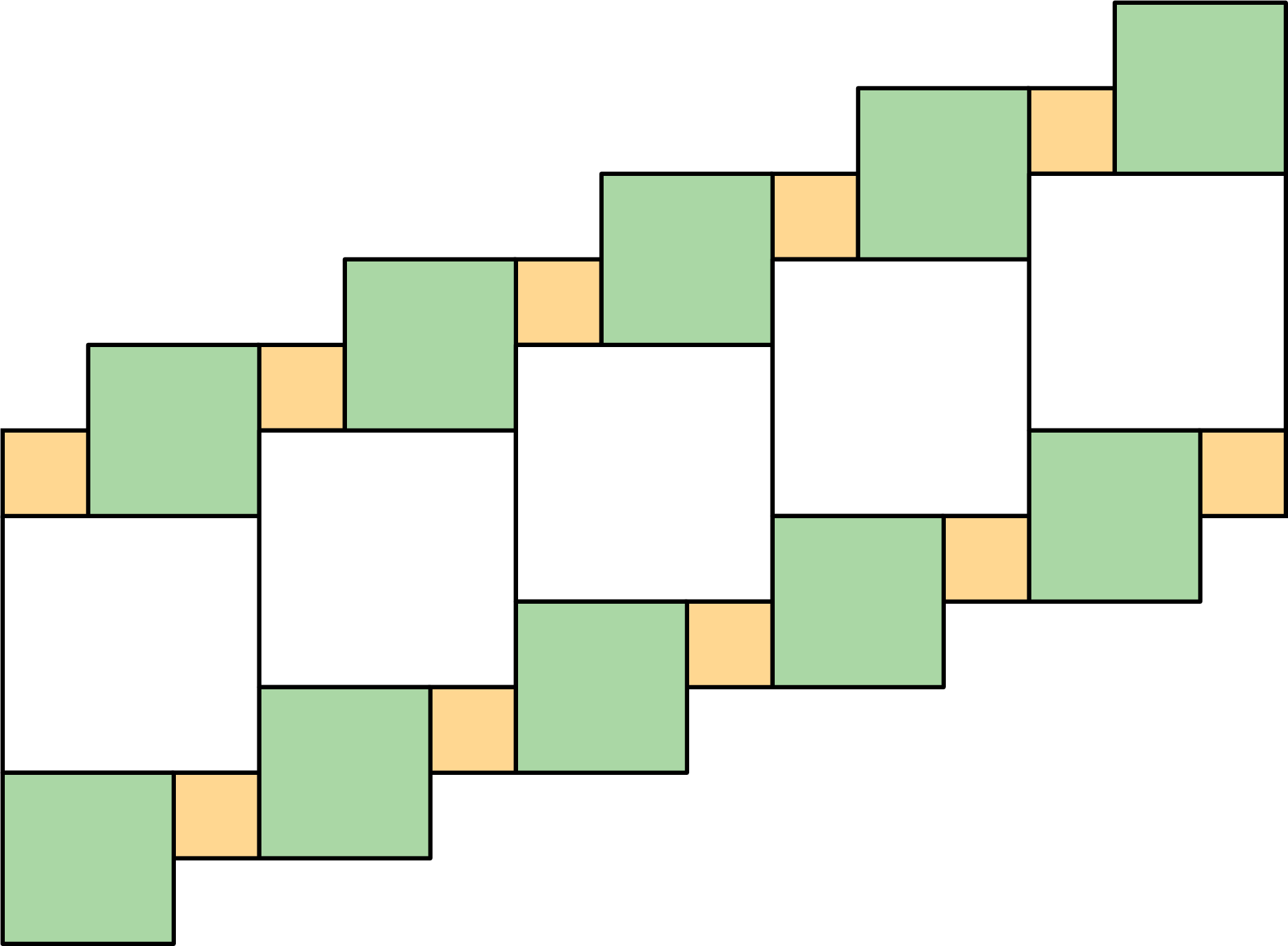
Unit 1: Practice Problem Sets
Lesson 1
Problem 1
Which square—large, medium, or small—covers more of the plane? Explain your reasoning.

Problem 2
Draw three different quadrilaterals, each with an area of 12 square units.
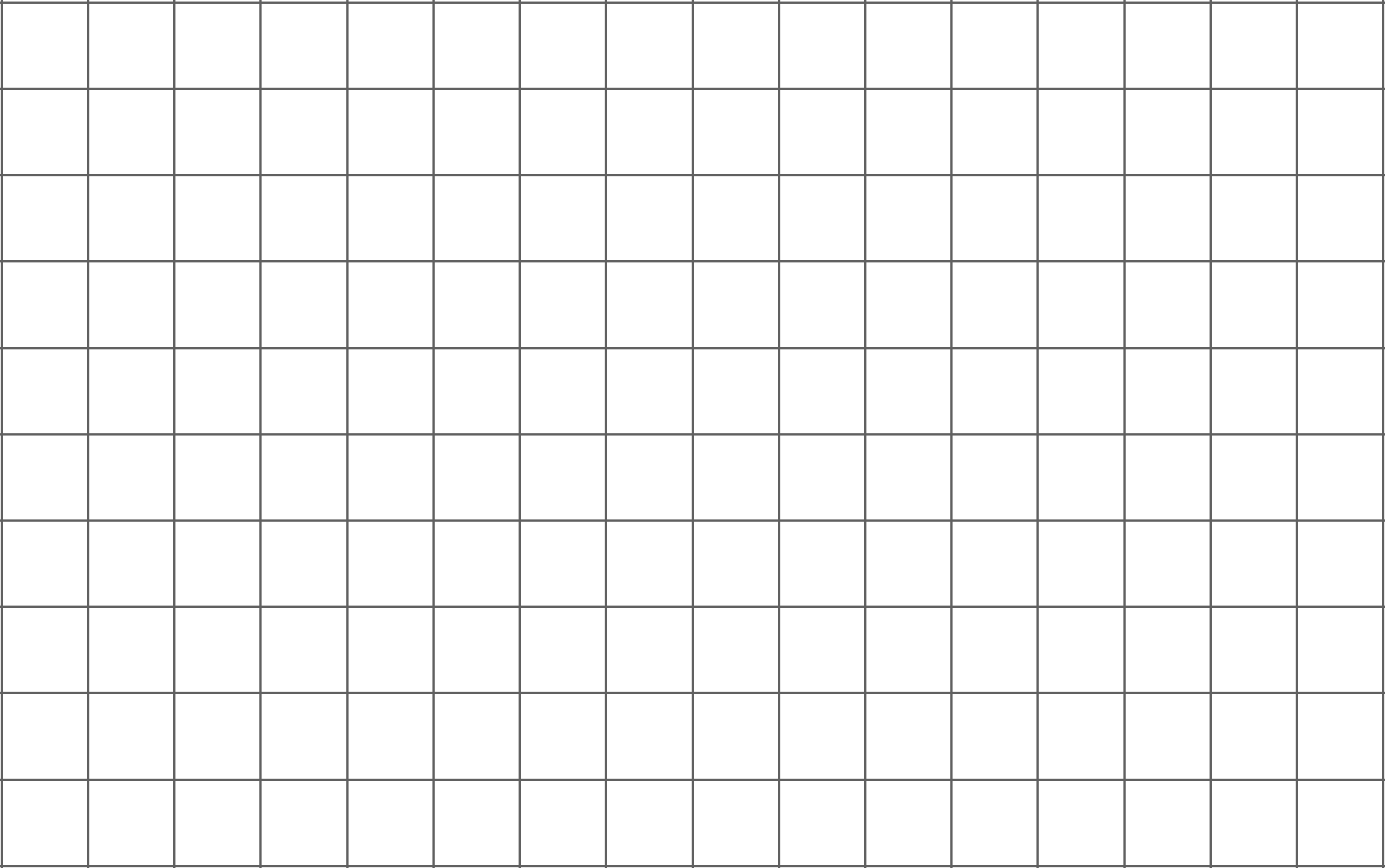
Problem 3
Use copies of the rectangle to show how a rectangle could:
a. tile the plane.

b. not tile the plane.

Problem 4
The area of this shape is 24 square units. Which of these statements is true about the area? Select all that apply.
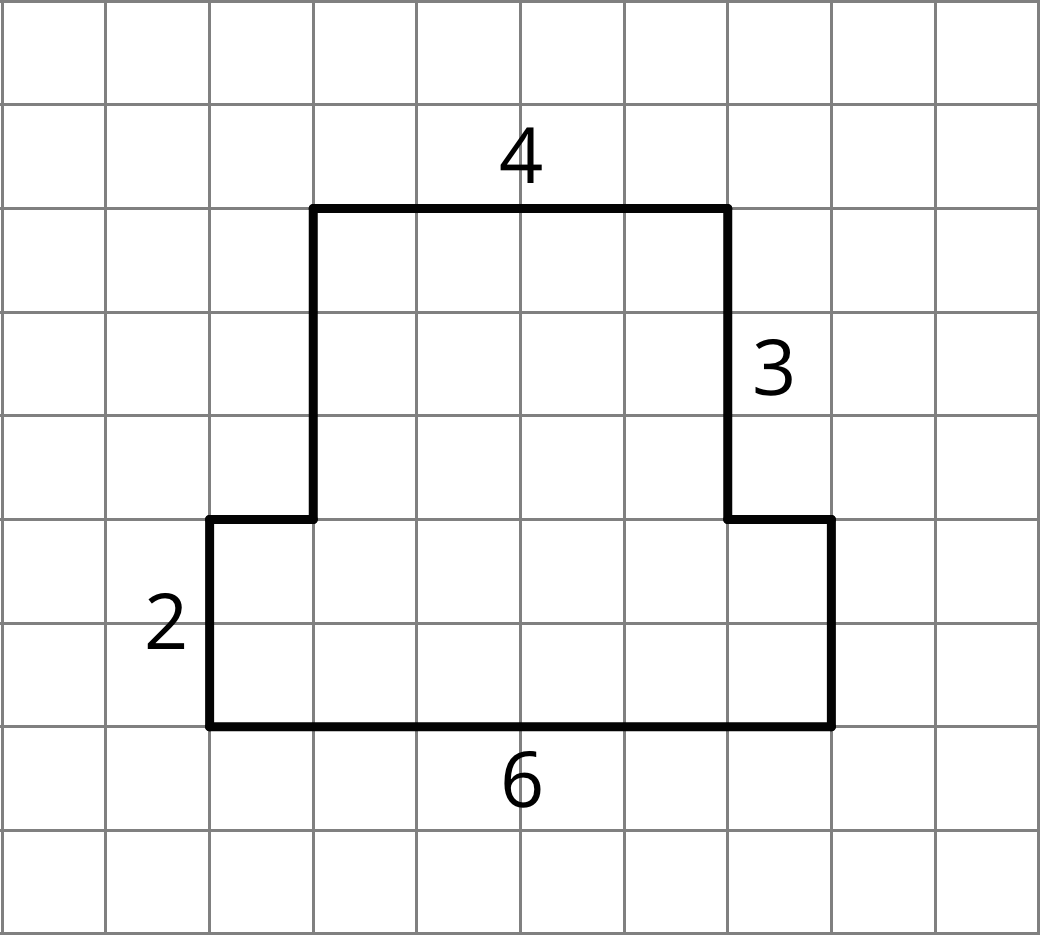
-
The area can be found by counting the number of squares that touch the edge of the shape.
-
It takes 24 grid squares to cover the shape without gaps and overlaps.
-
The area can be found by multiplying the sides lengths that are 6 units and 4 units.
- The area can be found by counting the grid squares inside the shape.
- The area can be found by adding 4 \times 3 and 6 \times 2.
Problem 5
Here are two copies of the same figure. Show two different ways for finding the area of the shaded region. All angles are right angles.
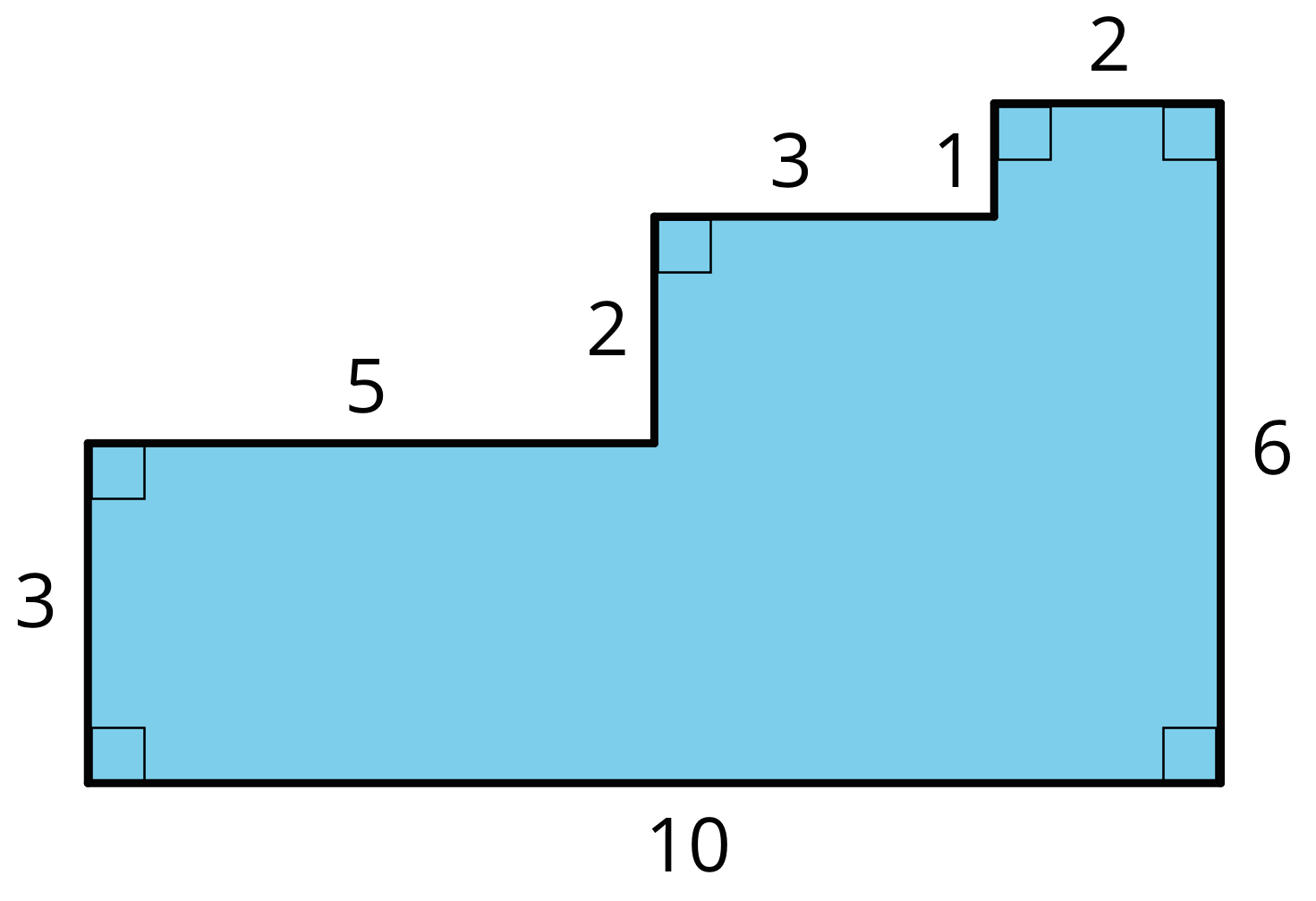

Problem 6
Which shape has a larger area: a rectangle that is 7 inches by \frac 34 inch, or a square with side length of 2 \frac12 inches? Show your reasoning.
Lesson 2
Problem 1
The diagonal of a rectangle is shown.

-
Decompose the rectangle along the diagonal, and recompose the two pieces to make a different shape.
-
How does the area of this new shape compare to the area of the original rectangle? Explain how you know.
Problem 2
The area of the square is 1 square unit. Two small triangles can be put together to make a square or to make a medium triangle.

Which figure also has an area of 1\frac 12 square units? Select all that apply.
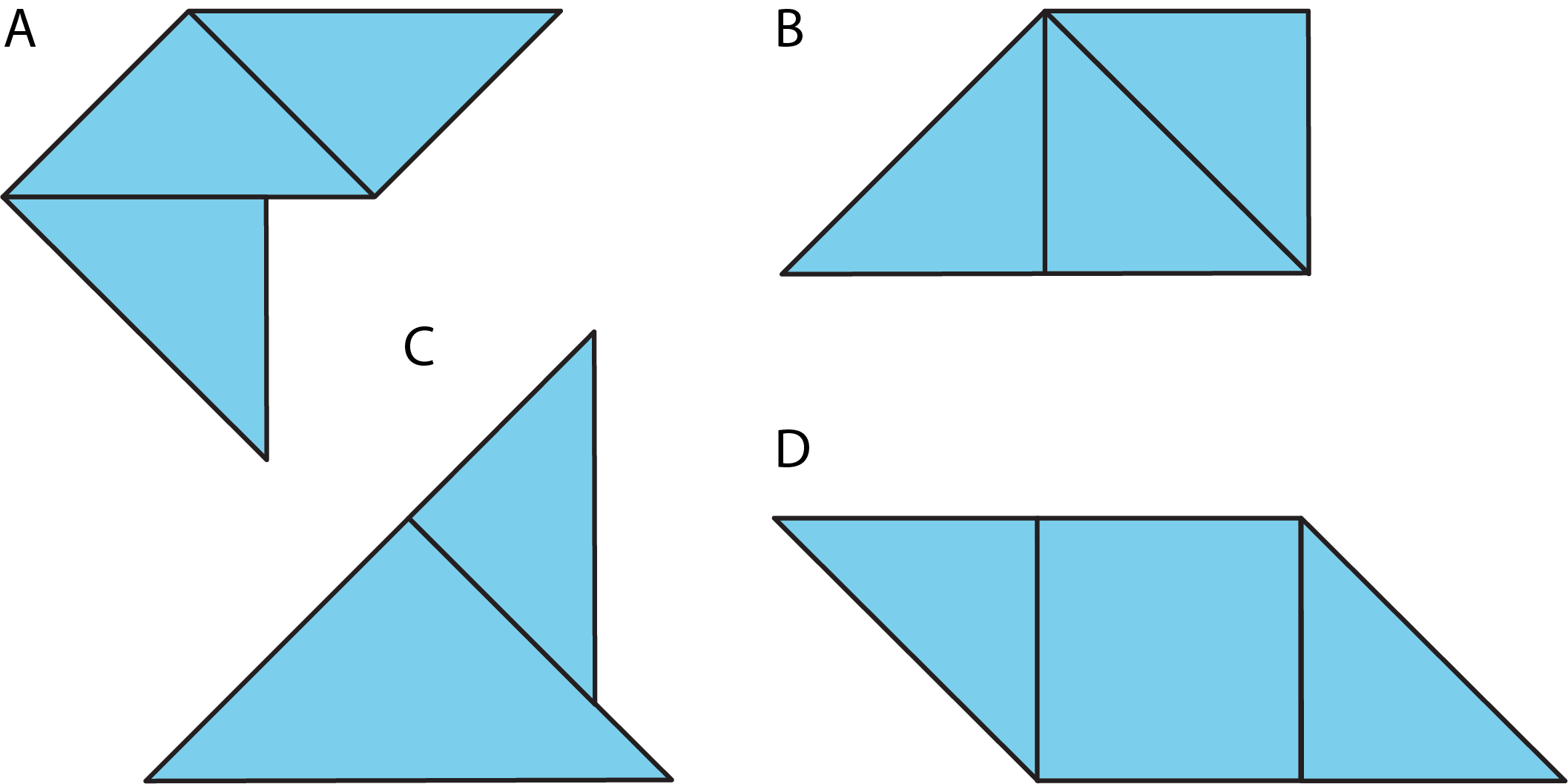
Problem 3
Priya decomposed a square into 16 smaller, equal-size squares and then cut out 4 of the small squares and attached them around the outside of original square to make a new figure.
How does the area of her new figure compare with that of the original square?
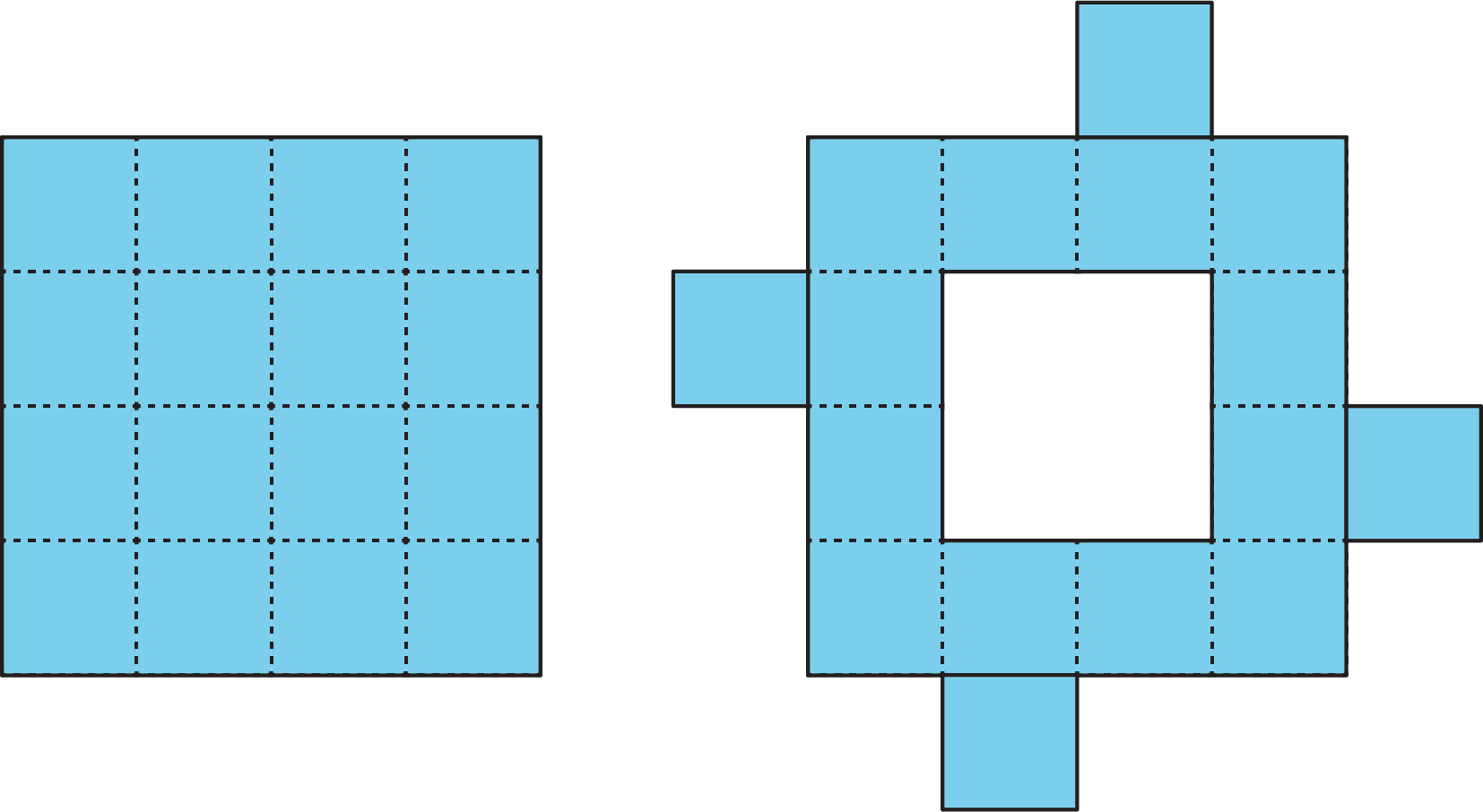
- The area of the new figure is greater.
- The two figures have the same area.
- The area of the original square is greater.
- We don’t know because neither the side length nor the area of the original square is known.
Problem 4 (from Unit 1, Lesson 1)
The area of a rectangular playground is 78 square meters. If the length of the playground is 13 meters, what is its width?
Problem 5 (from Unit 1, Lesson 1)
A student said, “We can’t find the area of the shaded region because the shape has many different measurements, instead of just a length and a width that we could multiply.”
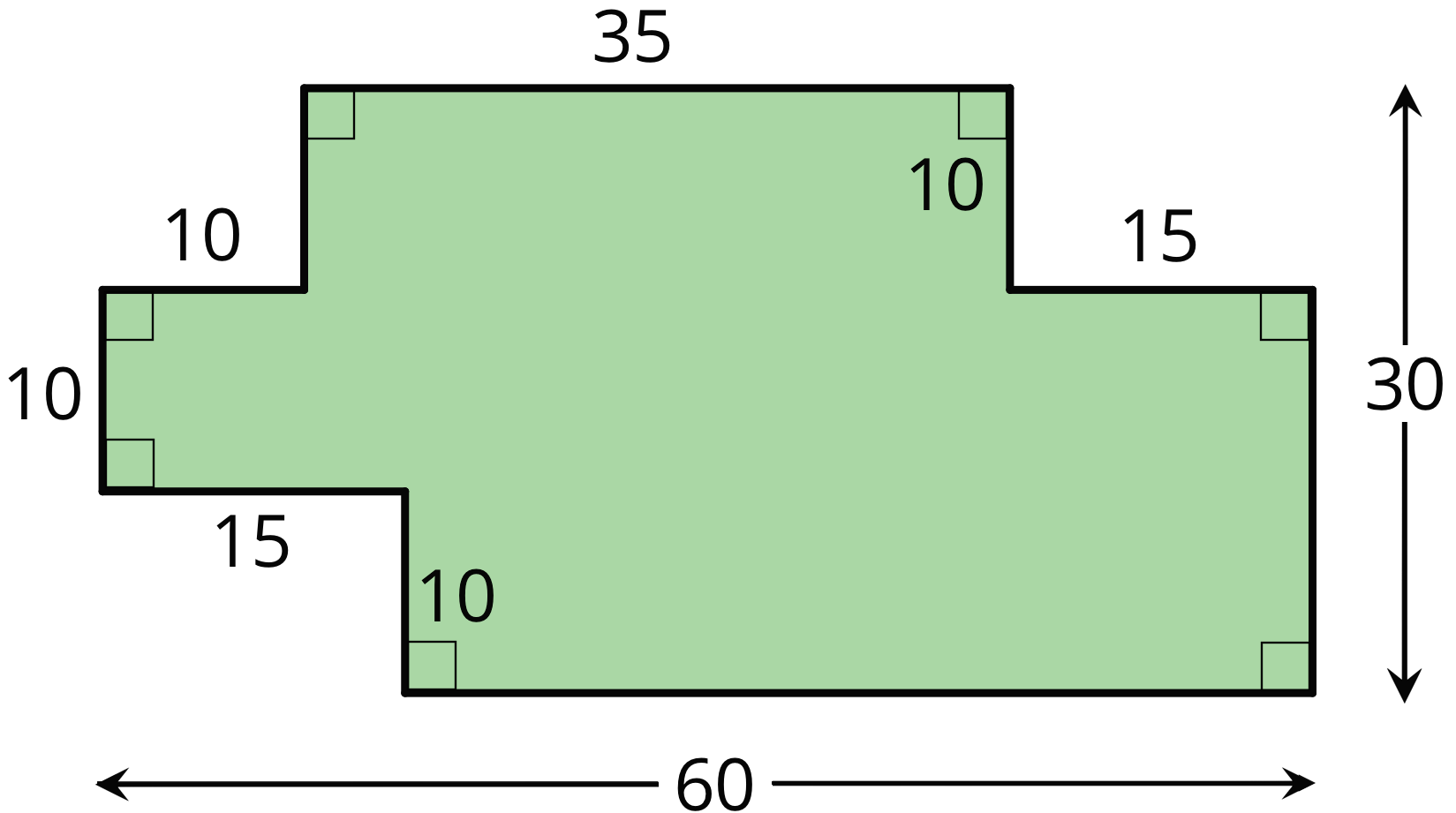
Explain why the student’s statement about area is incorrect.
Lesson 3
Problem 1
Find the area of each shaded region. Show your reasoning.

Problem 2
Find the area of each shaded region. Show or explain your reasoning.

Problem 3
Two plots of land have very different shapes. Noah said that both plots of land have the same area.
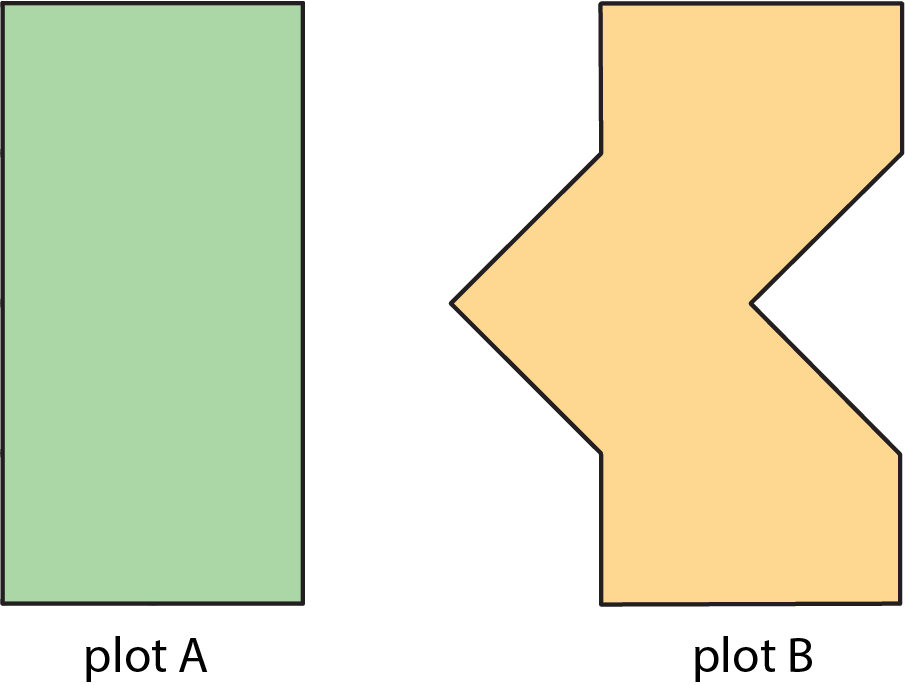
Do you agree with Noah? Explain your reasoning.
Problem 4 (from Unit 1, Lesson 2)
A homeowner is deciding on the size of tiles to use to fully tile a rectangular wall in her bathroom that is 80 inches by 40 inches. The tiles are squares and come in three side lengths: 8 inches, 4 inches, and 2 inches. State if you agree with each statement about the tiles. Explain your reasoning.
- Regardless of the size she chooses, she will need the same number of tiles.
- Regardless of the size she chooses, the area of the wall that is being tiled is the same.
- She will need two 2-inch tiles to cover the same area as one 4-inch tile.
- She will need four 4-inch tiles to cover the same area as one 8-inch tile.
- If she chooses the 8-inch tiles, she will need a quarter as many tiles as she would with 2-inch tiles.
Lesson 4
Problem 1
Select all of the parallelograms. For each figure that is not selected, explain how you know it is not a parallelogram.

Problem 2
a. Decompose and rearrange this parallelogram to make a rectangle.
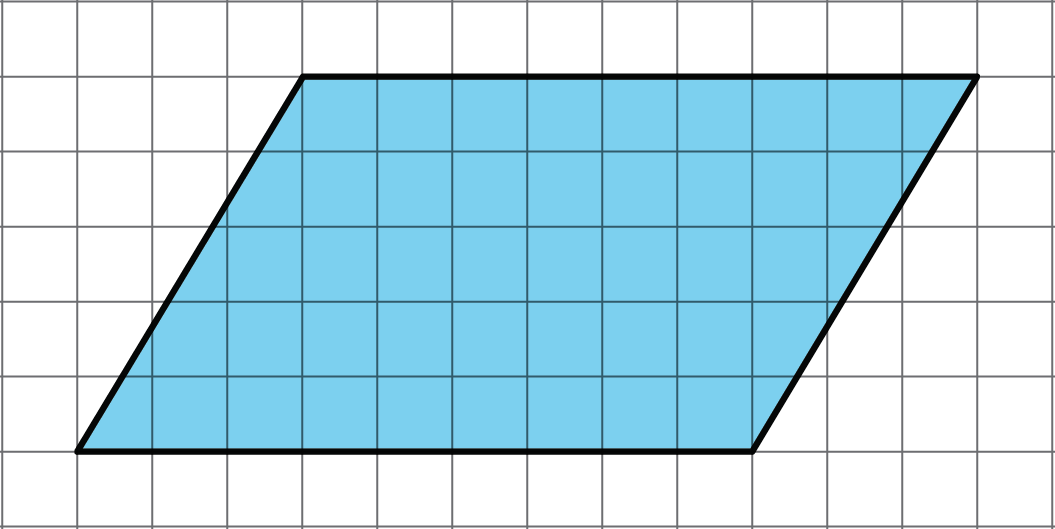
b. What is the area of the parallelogram? Explain your reasoning.
Problem 3
Find the area of the parallelogram.
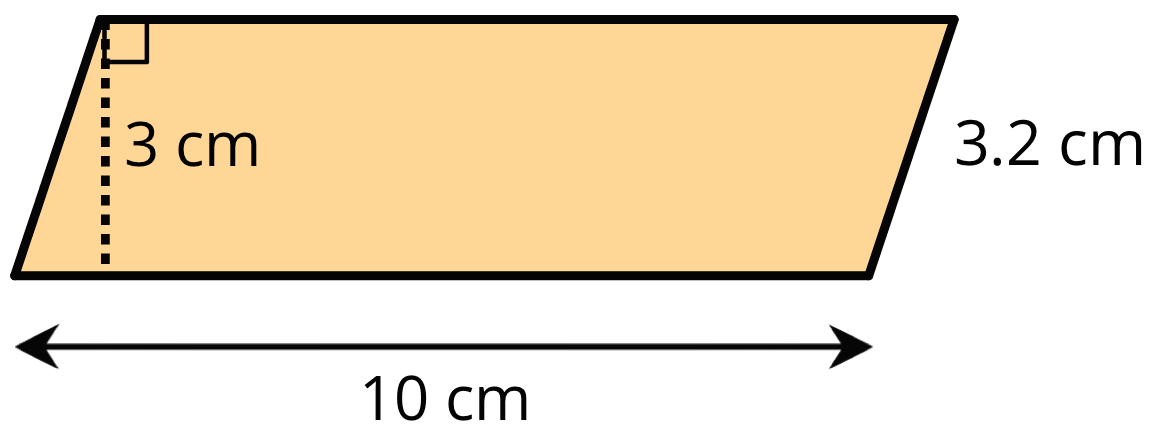
Problem 4
Explain why this quadrilateral is not a parallelogram.

Problem 5 (from Unit 1, Lesson 3)
Find the area of each shape. Show your reasoning.


Problem 6 (from Unit 1, Lesson 1)
Find the areas of the rectangles with the following side lengths.
-
5 in and \frac13 in
-
5 in and \frac 43 in
-
\frac 52 in and \frac 43 in
-
\frac 7 6 in and \frac 67 in
Lesson 5
Problem 1
Select all parallelograms that have a correct height labeled for the given base.
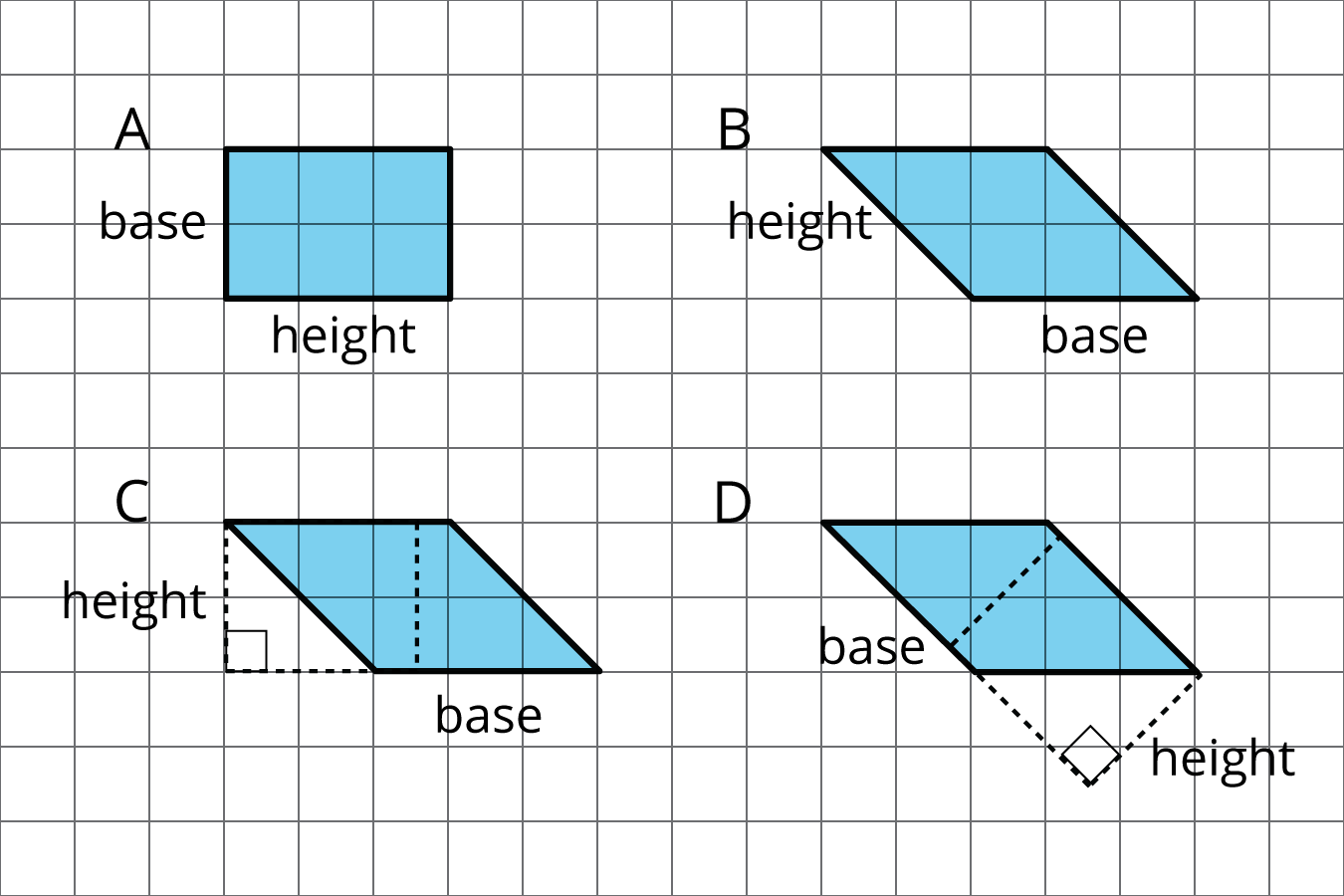
Problem 2
The side labeled b has been chosen as the base for this parallelogram.

Draw a segment showing the height corresponding to that base.
Problem 3
Find the area of each parallelogram.

Problem 4
If the side that is 6 units long is the base of this parallelogram, what is its corresponding height?
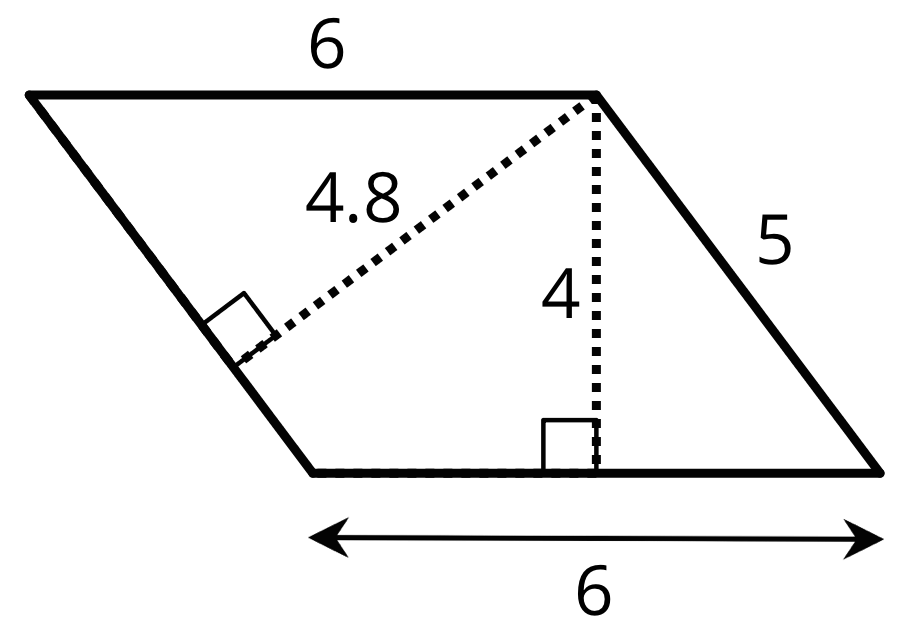
- 6 units
- 4.8 units
- 4 units
- 5 units
Problem 5
Find the area of each parallelogram.

Problem 6 (from Unit 1, Lesson 4)
Do you agree with each of these statements? Explain your reasoning.
- A parallelogram has six sides.
- Opposite sides of a parallelogram are parallel.
- A parallelogram can have one pair or two pairs of parallel sides.
- All sides of a parallelogram have the same length.
- All angles of a parallelogram have the same measure.
Problem 7 (from Unit 1, Lesson 2)
A square with an area of 1 square meter is decomposed into 9 identical small squares. Each small square is decomposed into two identical triangles.
- What is the area, in square meters, of 6 triangles? If you get stuck, draw a diagram.
- How many triangles are needed to compose a region that is 1\frac 12 square meters?
Lesson 6
Problem 1

Problem 2
Which of the following pairs of base and height produces the greatest area? All measurements are in centimeters.
- b = 4, h=3.5
- b = 0.8, h=20
- b = 6, h=2.25
- b = 10, h=1.4
Problem 3
Here are the areas of three parallelograms. Use them to find the missing length (labeled with a "?") on each parallelogram.
A: 10 square units
B: 21 square units
C: 25 square units

Problem 4
The Dockland Building in Hamburg, Germany is shaped like a parallelogram.

If the length of the building is 86 meters and its height is 55 meters, what is the area of this face of the building?
Problem 5 (from Unit 1, Lesson 5)
Select all segments that could represent a corresponding height if the side m is the base.

Problem 6 (from Unit 1, Lesson 3)
Find the area of the shaded region. All measurements are in centimeters. Show your reasoning.
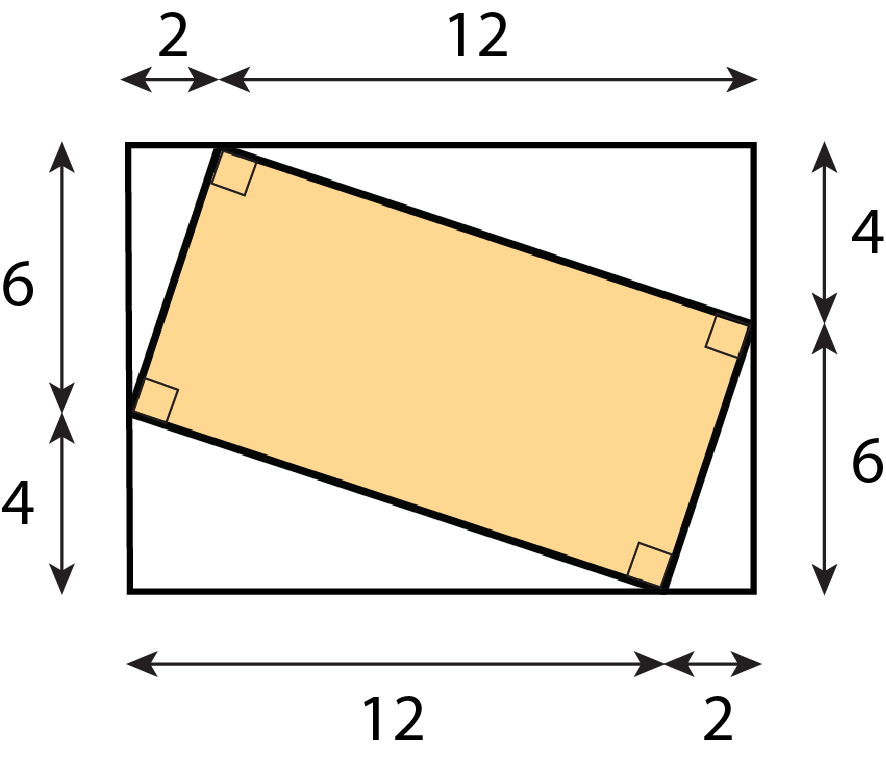
Lesson 7
Problem 1
To decompose a quadrilateral into two identical shapes, Clare drew a dashed line as shown in the diagram.
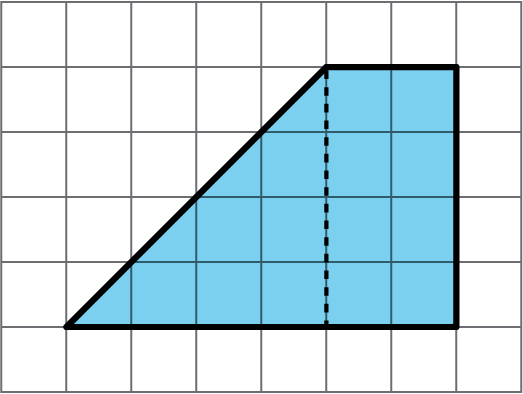
-
She said the that two resulting shapes have the same area. Do you agree? Explain your reasoning.
-
Did Clare partition the figure into two identical shapes? Explain your reasoning.
Problem 2
Triangle R is a right triangle. Can we use two copies of Triangle R to compose a parallelogram that is not a square?
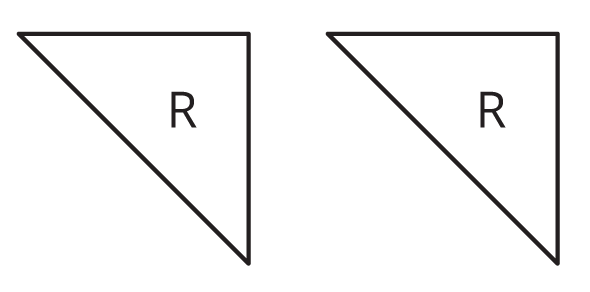
If so, explain how or sketch a solution. If not, explain why not.
Problem 3
Two copies of this triangle are used to compose a parallelogram. Which parallelogram cannot be a result of the composition? If you get stuck, consider using tracing paper.
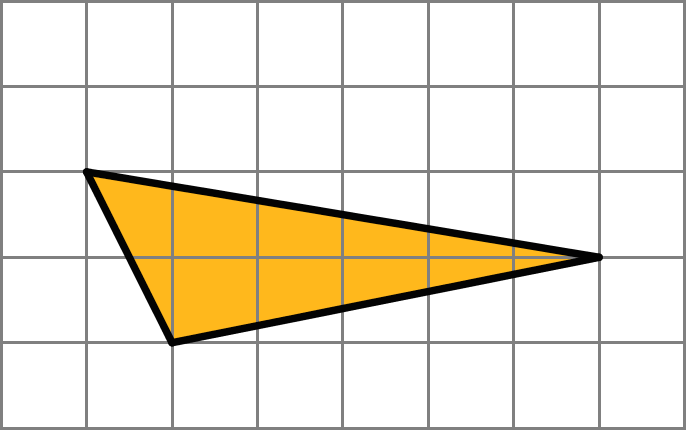

Problem 4
a. On the grid, draw at least three different quadrilaterals that can each be decomposed into two identical triangles with a single cut (show the cut line). One or more of the quadrilaterals should have non-right angles.

b. Identify the type of each quadrilateral.
Problem 5 (from Unit 1, Lesson 6)
-
A parallelogram has a base of 9 units and a corresponding height of \frac23 units. What is its area?
-
A parallelogram has a base of 9 units and an area of 12 square units. What is the corresponding height for that base?
-
A parallelogram has an area of 7 square units. If the height that corresponds to a base is \frac14 unit, what is the base?
Problem 6 (from Unit 1, Lesson 5)
Select all segments that could represent a corresponding height if the side n is the base.

Lesson 8
Problem 1
To find the area of this right triangle, Diego and Jada used different strategies. Diego drew a line through the midpoints of the two longer sides, which decomposes the triangle into a trapezoid and a smaller triangle. He then rearranged the two shapes into a parallelogram.
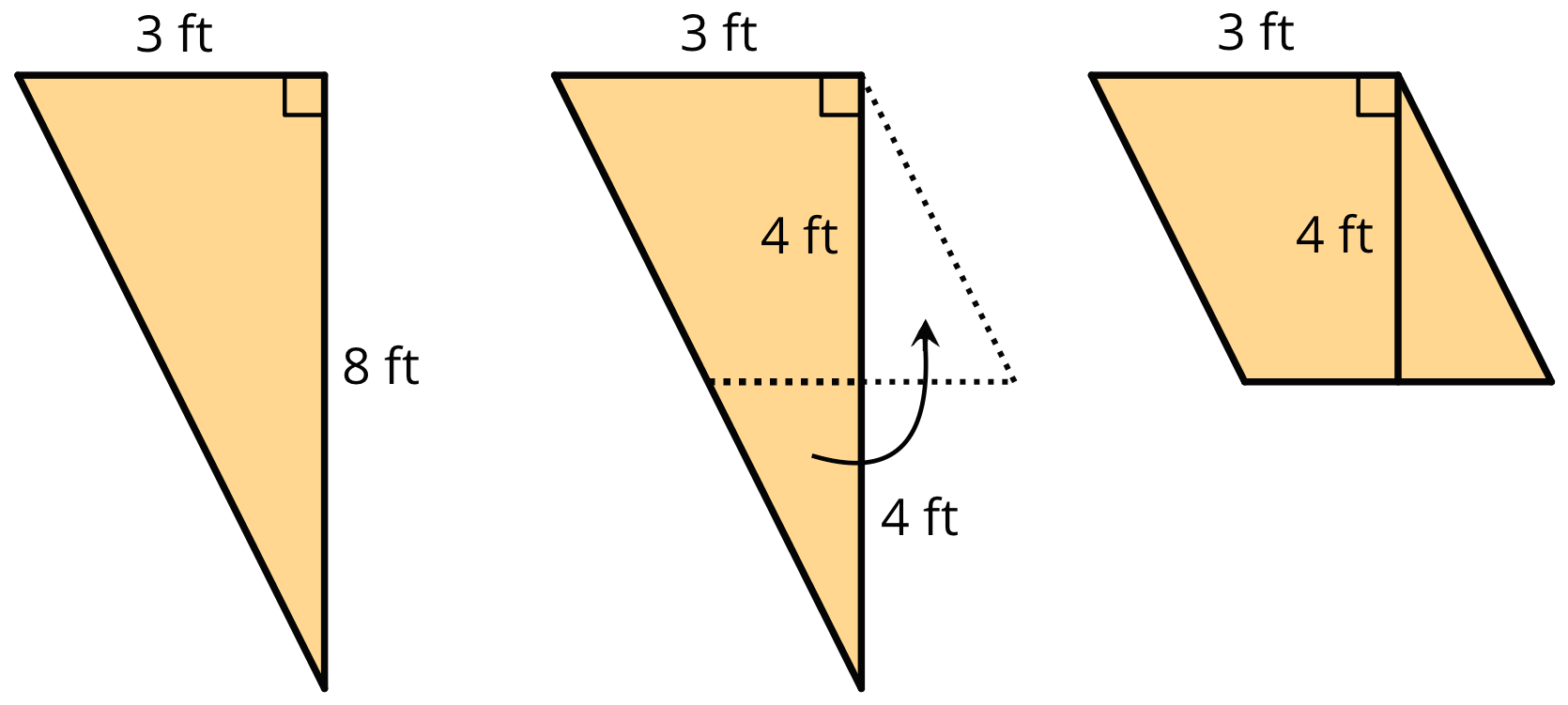
Jada made a copy of the triangle, rotated it, and lined it up against one side of the original triangle so that the two triangles make a parallelogram.
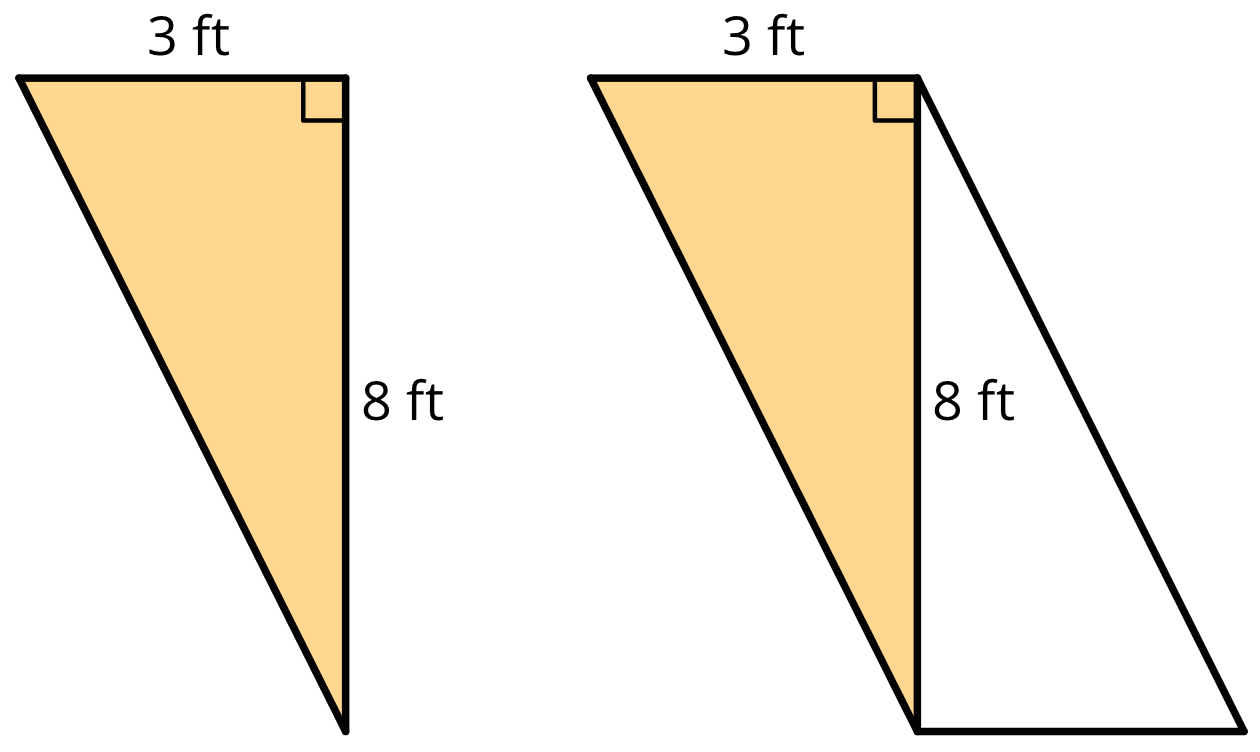
- Explain how Diego might use his parallelogram to find the area of the triangle.
- Explain how Jada might use her parallelogram to find the area of the triangle.
Problem 2
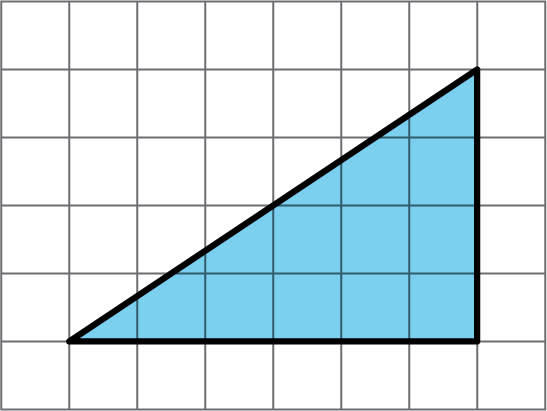
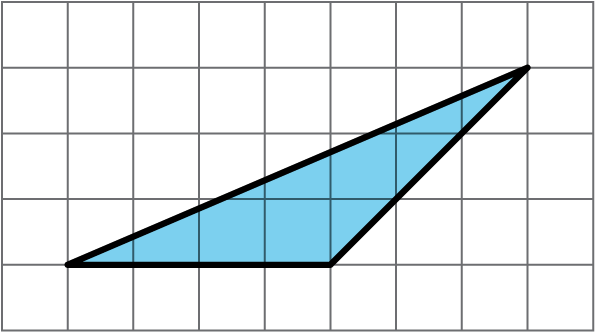
Problem 3
Which of the three triangles has the greatest area? Show your reasoning.
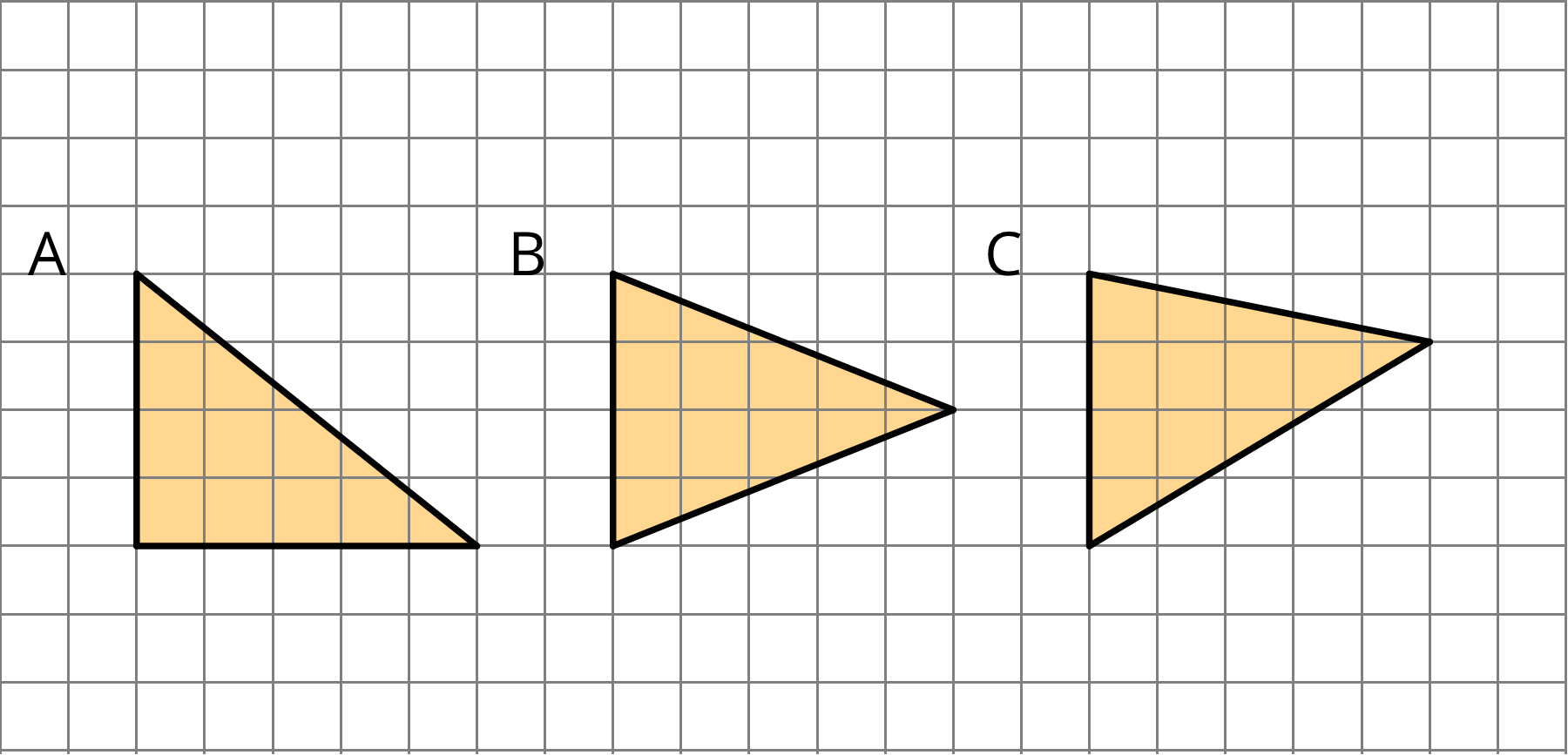
If you get stuck, use what you know about the area of parallelograms to help you.
Problem 4 (from Unit 1, Lesson 7)
Draw an identical copy of each triangle such that the two copies together form a parallelogram. If you get stuck, consider using tracing paper.
Problem 5 (from Unit 1, Lesson 6)
-
A parallelogram has a base of 3.5 units and a corresponding height of 2 units. What is its area?
-
A parallelogram has a base of 3 units and an area of 1.8 square units. What is the corresponding height for that base?
-
A parallelogram has an area of 20.4 square units. If the height that corresponds to a base is 4 units, what is the base?
Lesson 9
Problem 1
Select all drawings in which a corresponding height h for a given base b is correctly identified.
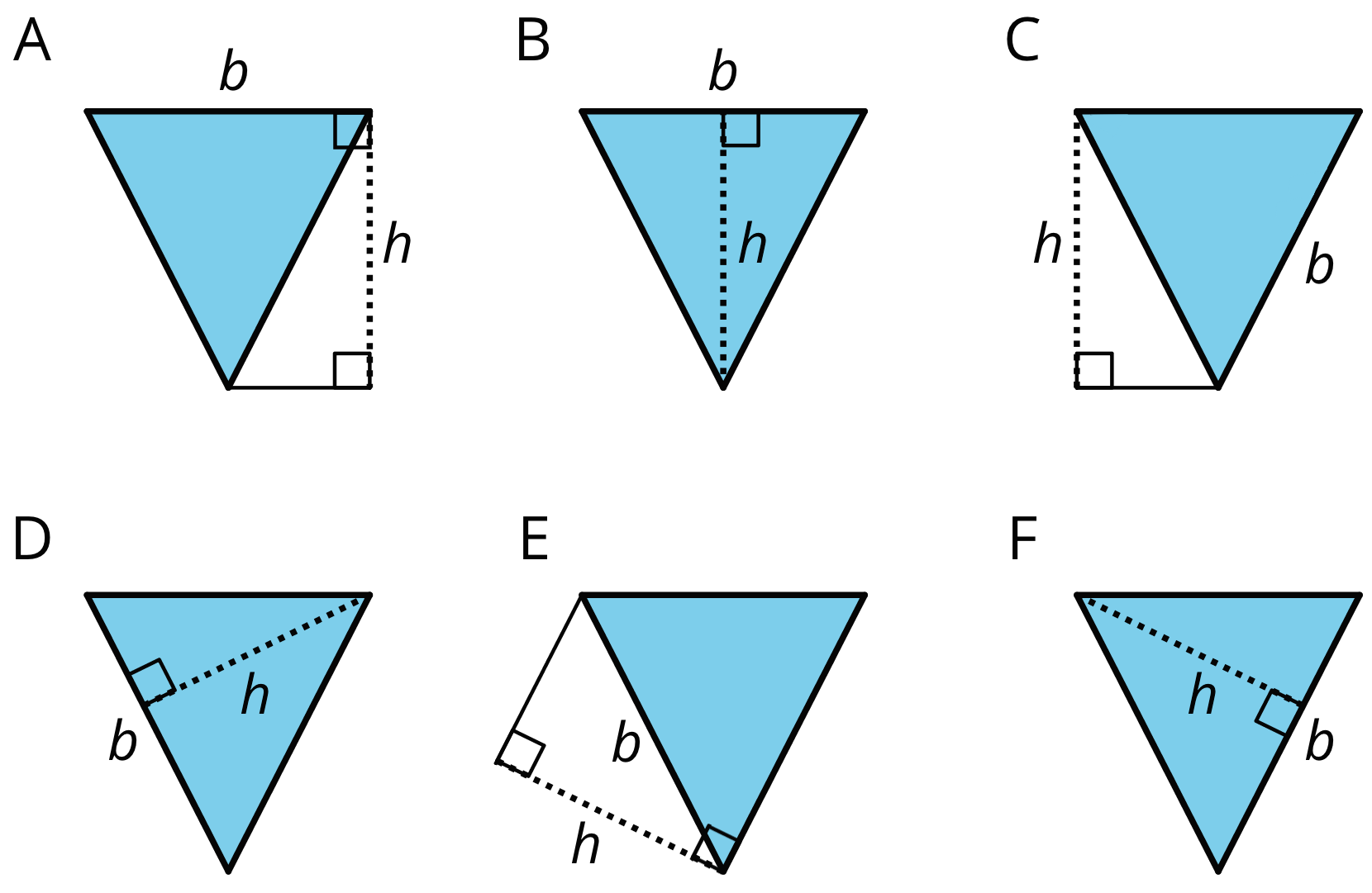
Problem 2
For each triangle, a base and its corresponding height are labeled.

a. Find the area of each triangle.
b. How is the area related to the base and its corresponding height?
Problem 3
Here is a right triangle. Name a corresponding height for each base.
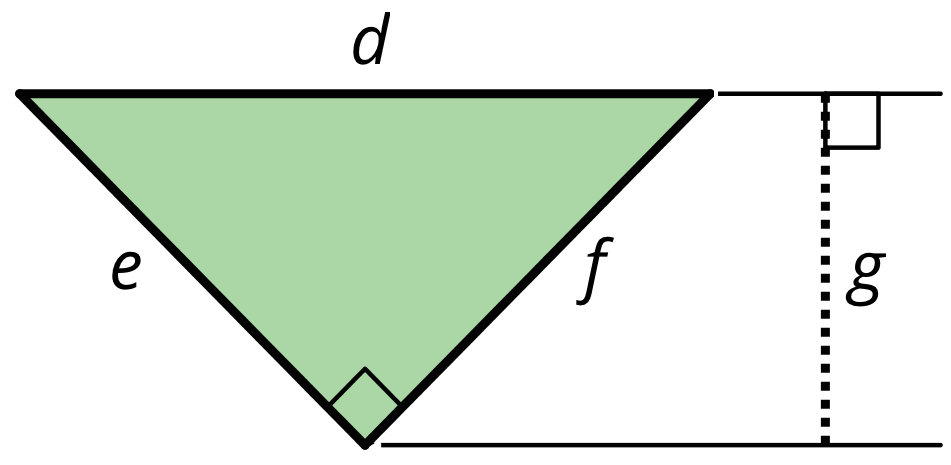
- Side d
- Side e
- Side f
Problem 4 (from Unit 1, Lesson 8)
Find the area of the shaded triangle. Show your reasoning.

Problem 5 (from Unit 1, Lesson 7)
Andre drew a line connecting two opposite corners of a parallelogram. Select all true statements about the triangles created by the line Andre drew.
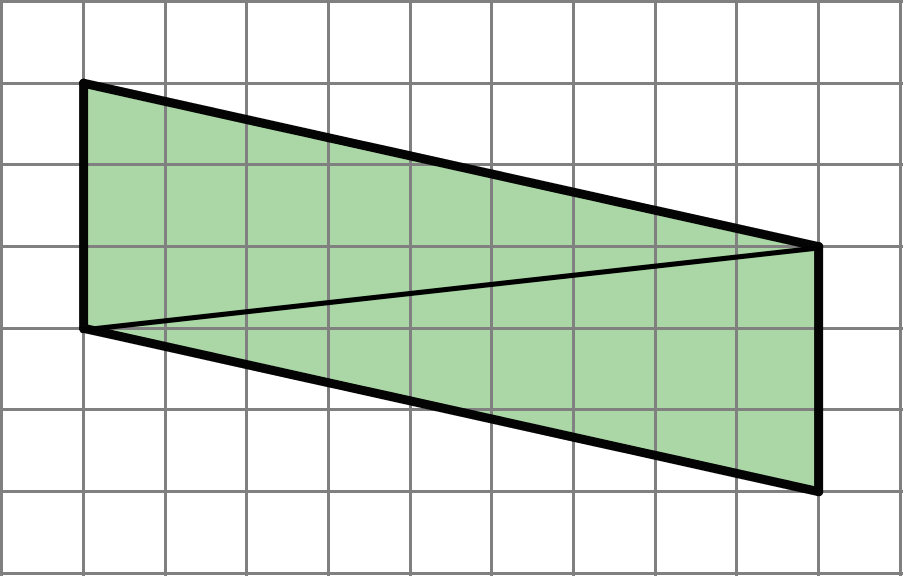
- Each triangle has two sides that are 3 units long.
- Each triangle has a side that is the same length as the diagonal line.
- Each triangle has one side that is 3 units long.
- When one triangle is placed on top of the other and their sides are aligned, we will see that one triangle is larger than the other.
- The two triangles have the same area as each other.
Problem 6 (from Unit 1, Lesson 3)
Here is an octagon.
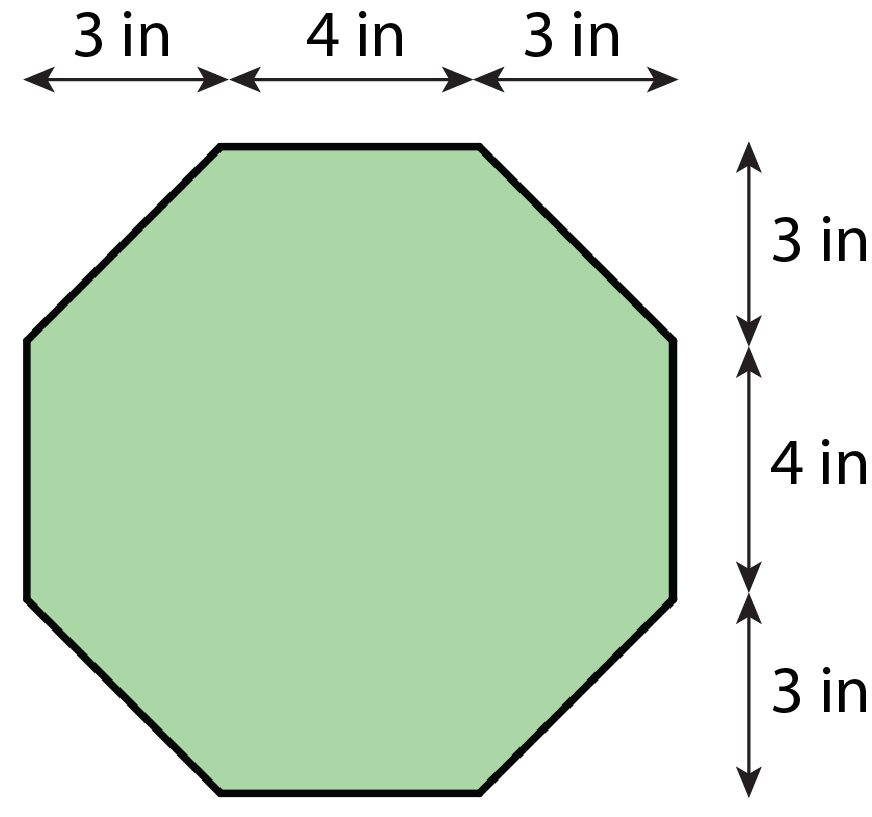
- While estimating the area of the octagon, Lin reasoned that it must be less than 100 square inches. Do you agree? Explain your reasoning.
- Find the exact area of the octagon. Show your reasoning.
Lesson 10
Problem 1
For each triangle, a base is labeled b. Draw a line segment that shows its corresponding height. Use an index card to help you draw a straight line.

Problem 2
Select all triangles that have an area of 8 square units. Explain how you know.
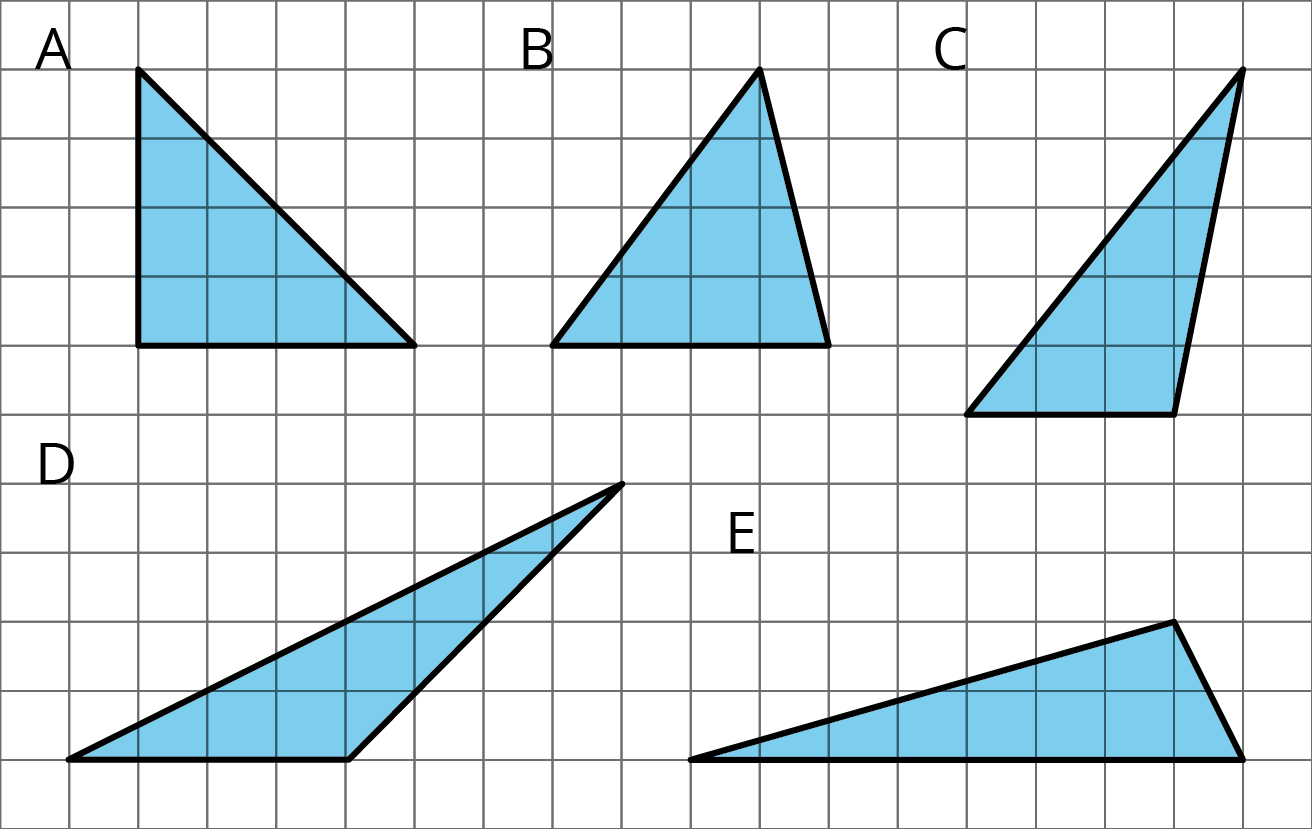
Problem 3
Find the area of the triangle. Show your reasoning.

If you get stuck, carefully consider which side of the triangle to use as the base.
Problem 4
Can side d be the base for this triangle? If so, which length would be the corresponding height? If not, explain why not.

Problem 5 (from Unit 1, Lesson 3)
Find the area of this shape. Show your reasoning.

Problem 6 (from Unit 1, Lesson 6)
On the grid, sketch two different parallelograms that have equal area. Label a base and height of each and explain how you know the areas are the same.

Lesson 11
Problem 1
Select all the polygons.
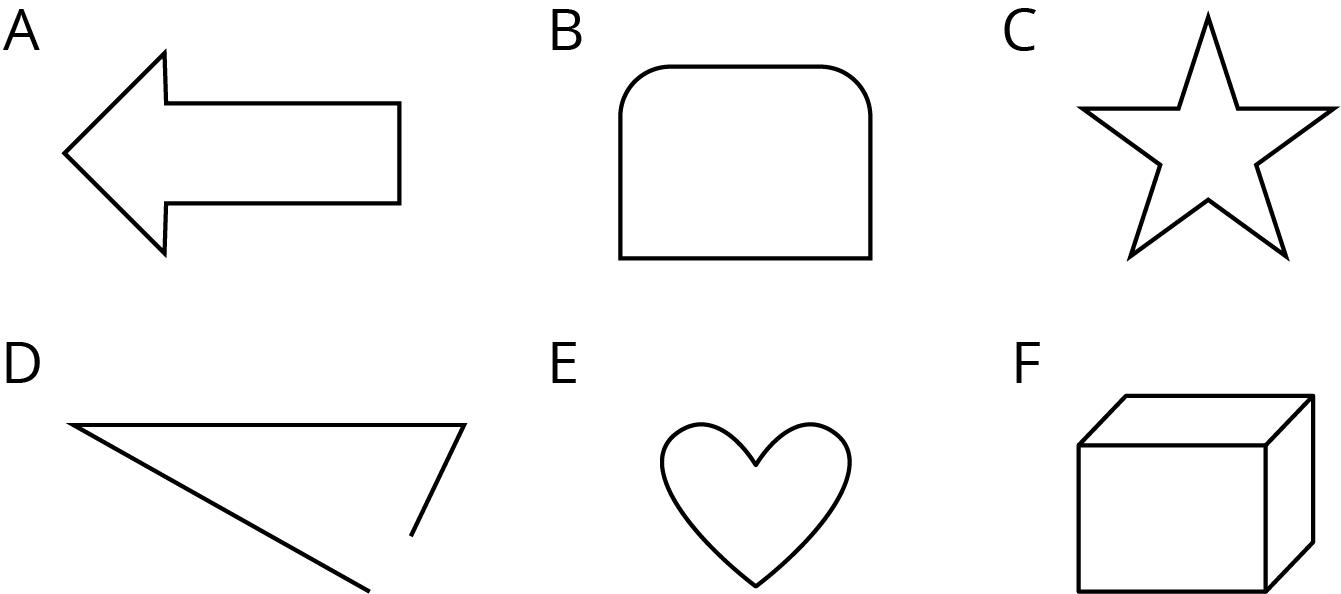
Problem 2
Mark each vertex with a large dot. How many edges and vertices does this polygon have?
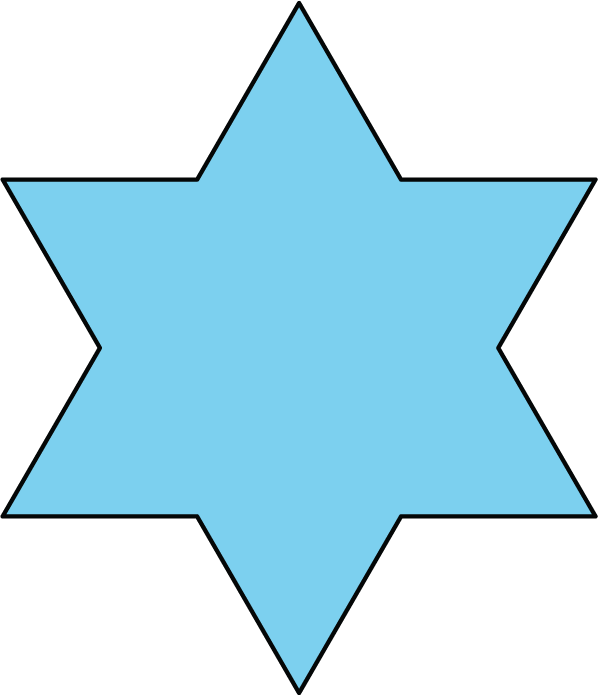
Problem 3
Find the area of this trapezoid. Explain or show your strategy.
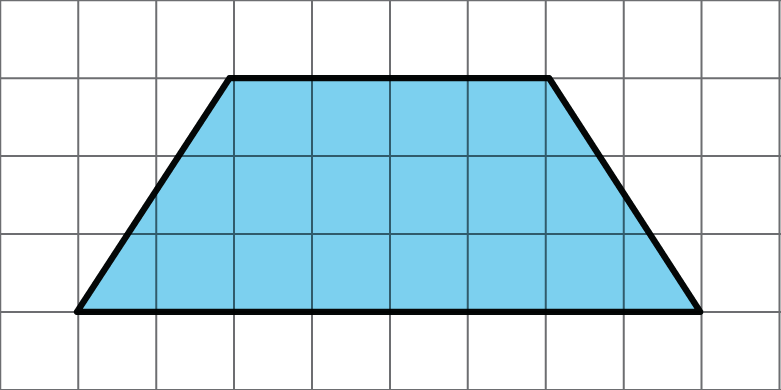
Problem 4
Lin and Andre used different methods to find the area of a regular hexagon with 6-inch sides. Lin decomposed the hexagon into six identical triangles. Andre decomposed the hexagon into a rectangle and two triangles.
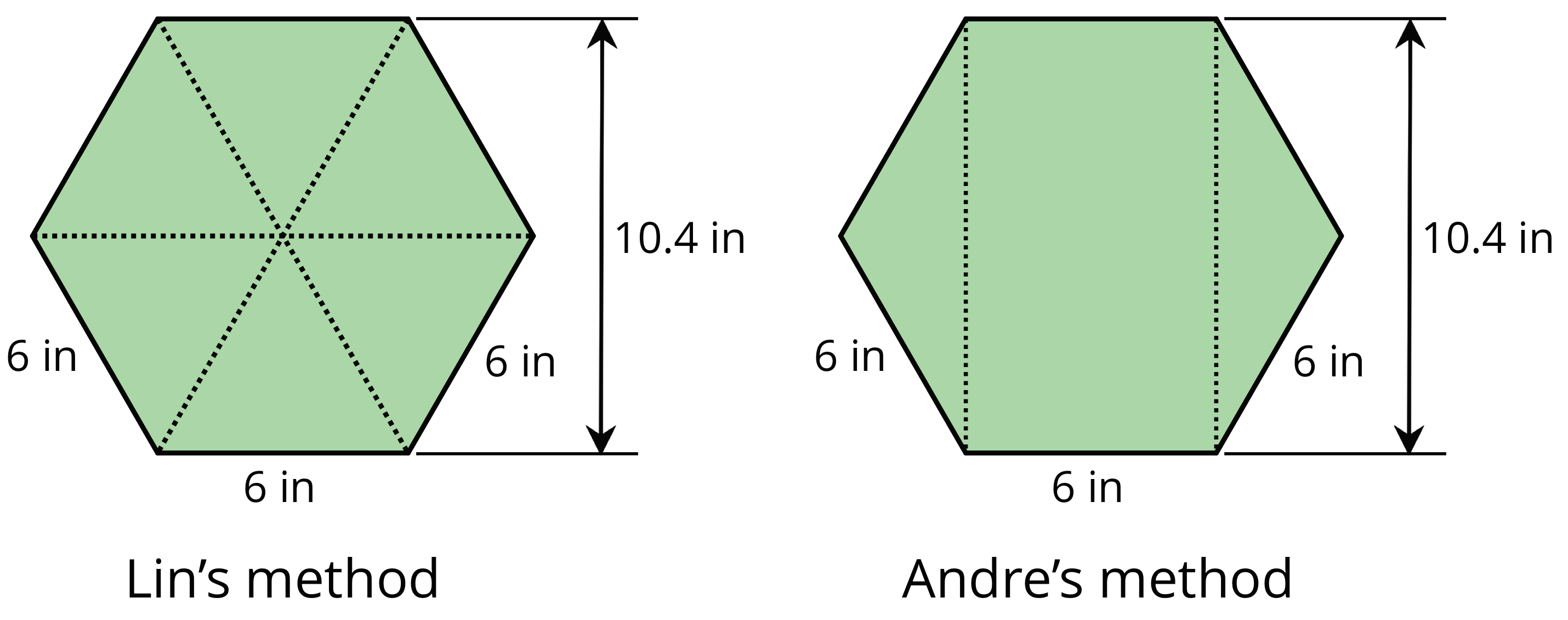
Find the area of the hexagon using each person’s method. Show your reasoning.
Problem 5 (from Unit 1, Lesson 9)
-
Identify a base and a corresponding height that can be used to find the area of this triangle. Label the base b and the corresponding height h.

2. Find the area of the triangle. Show your reasoning.
Problem 6 (from Unit 1, Lesson 10)
On the grid, draw three different triangles with an area of 12 square units. Label the base and height of each triangle.
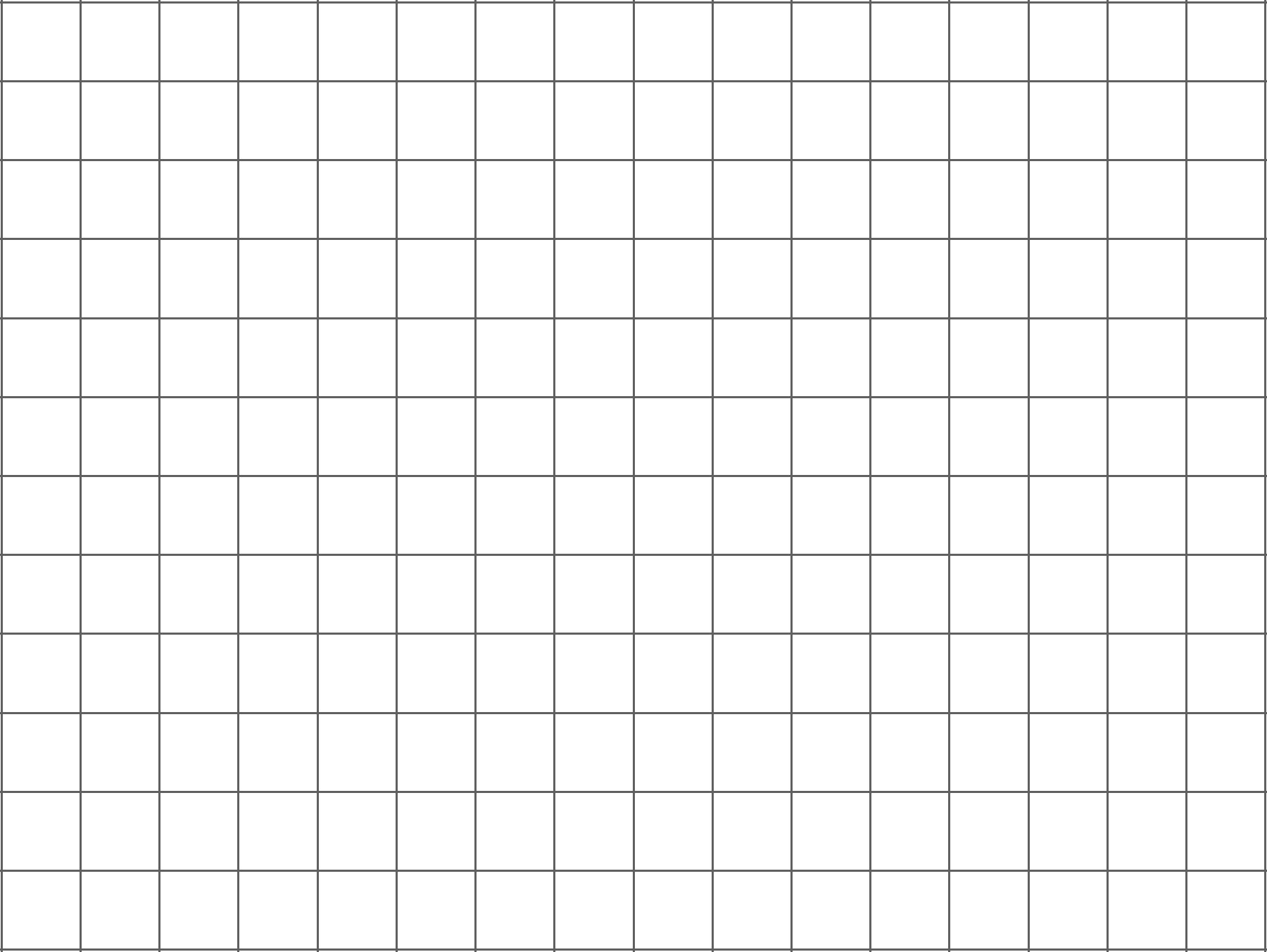
Lesson 12
Problem 1
What is the surface area of this rectangular prism?
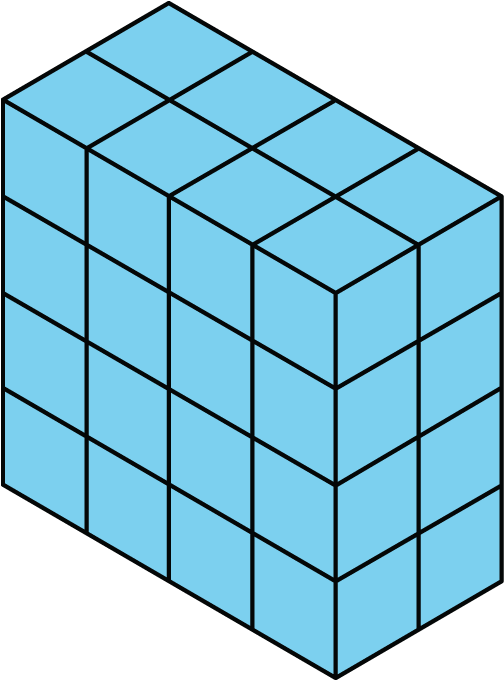
- 16 square units
- 32 square units
- 48 square units
- 64 square units
Problem 2
Which description can represent the surface area of this trunk?
- The number of square inches that cover the top of the trunk.
- The number of square feet that cover all the outside faces of the trunk.
- The number of square inches of
horizontal surface inside the trunk. - The number of cubic feet that can be packed inside the trunk.

Problem 3
Which figure has a greater surface area?
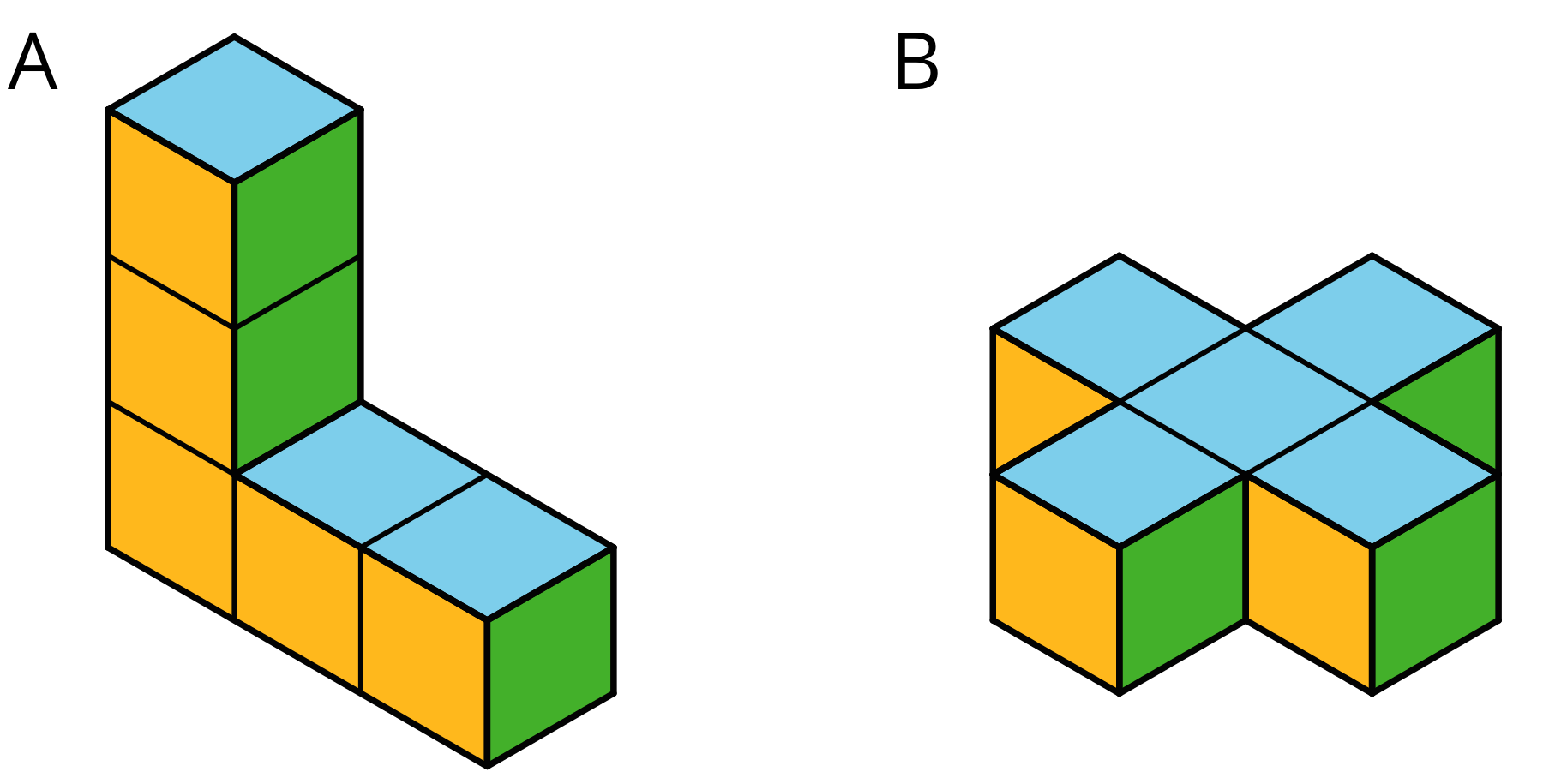
Problem 4
Problem 5 (from Unit 1, Lesson 9)
Draw an example of each of the following triangles on the grid.

- A right triangle with an area of 6 square units.
- An acute triangle with an area of 6 square units.
- An obtuse triangle with an area of 6 square units.
Problem 6 (from Unit 1, Lesson 10)
Find the area of triangle MOQ in square units. Show your reasoning.
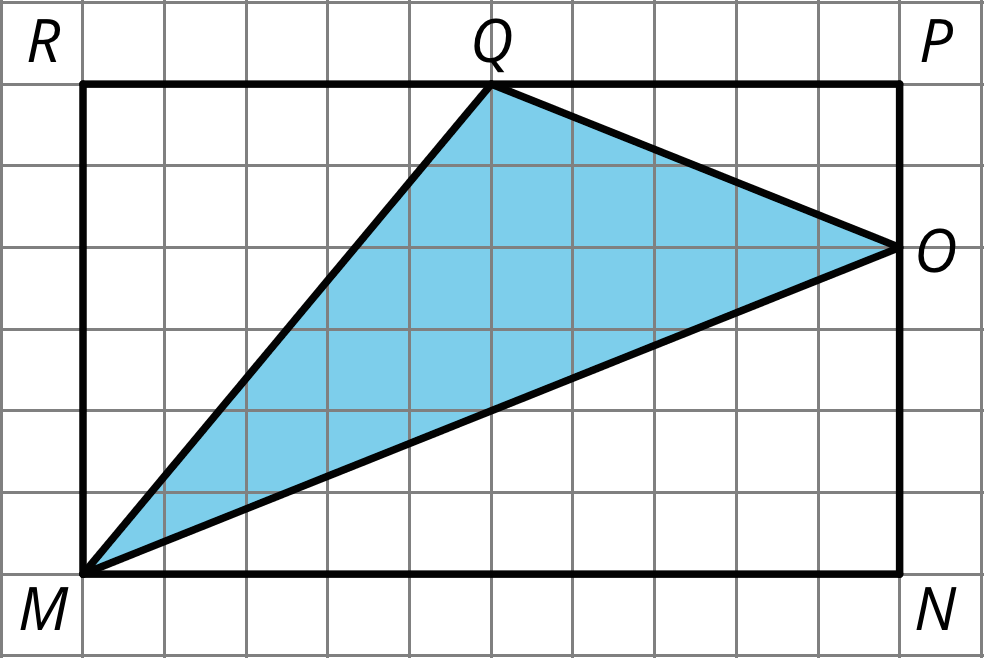
Problem 7 (from Unit 1, Lesson 3)
Find the area of this shape. Show your reasoning.

Lesson 13
Problem 1
Select all the polyhedra.

Problem 2
- Is this polyhedron a prism, a pyramid, or neither? Explain how you know.
- How many faces, edges, and vertices does it have?
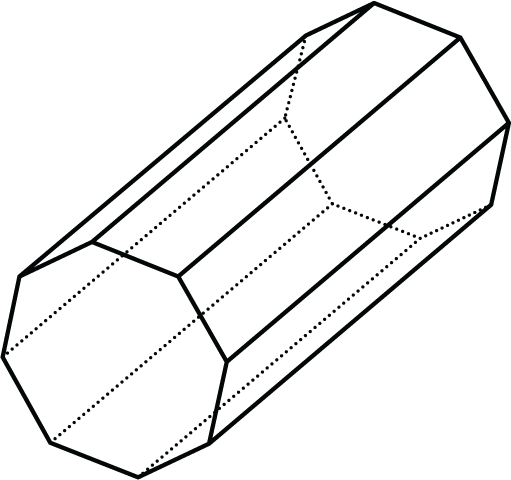
Problem 3
Tyler said this net cannot be a net for a square prism because not all the faces are squares.
Do you agree with Tyler's statement? Explain your reasoning.
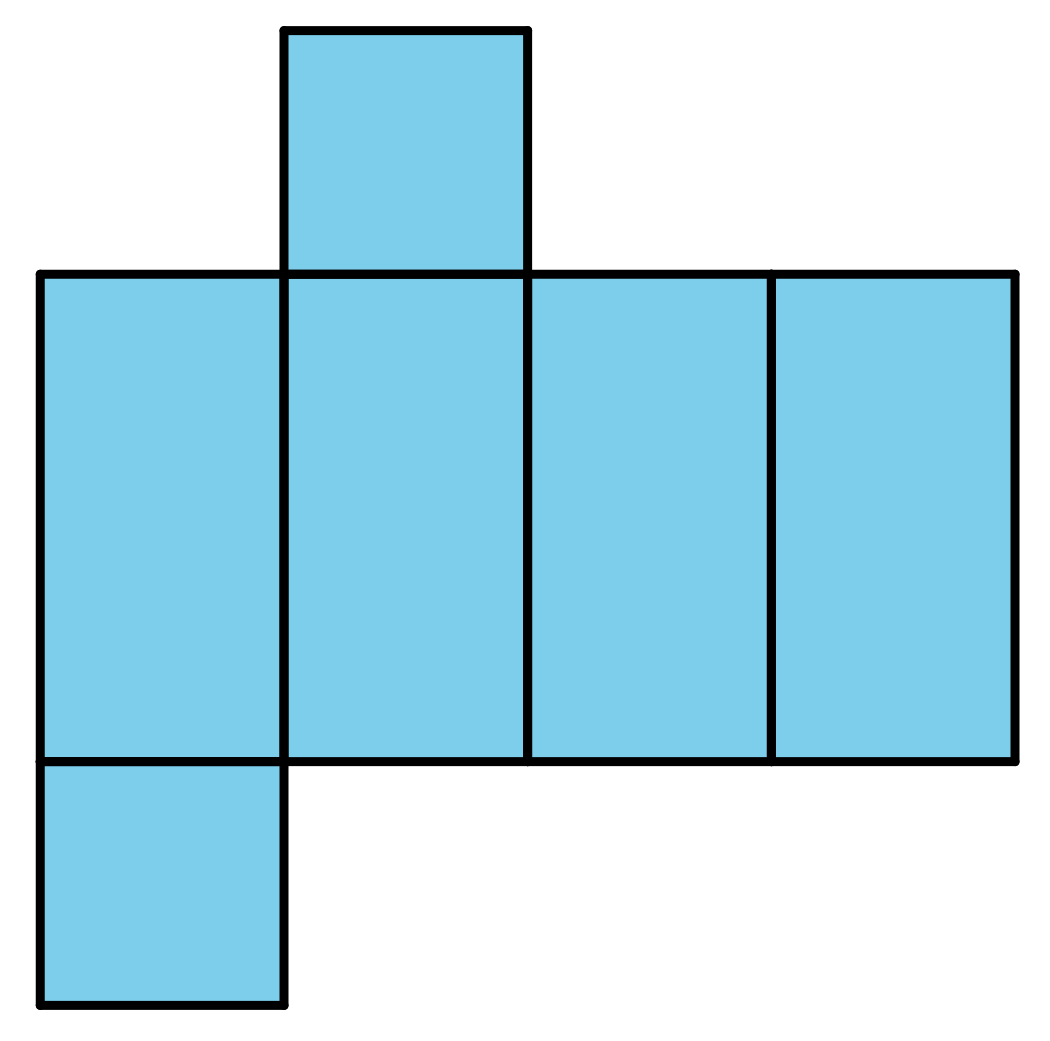
Problem 4 (from Unit 1, Lesson 8)
Explain why each of the following triangles has an area of 9 square units.
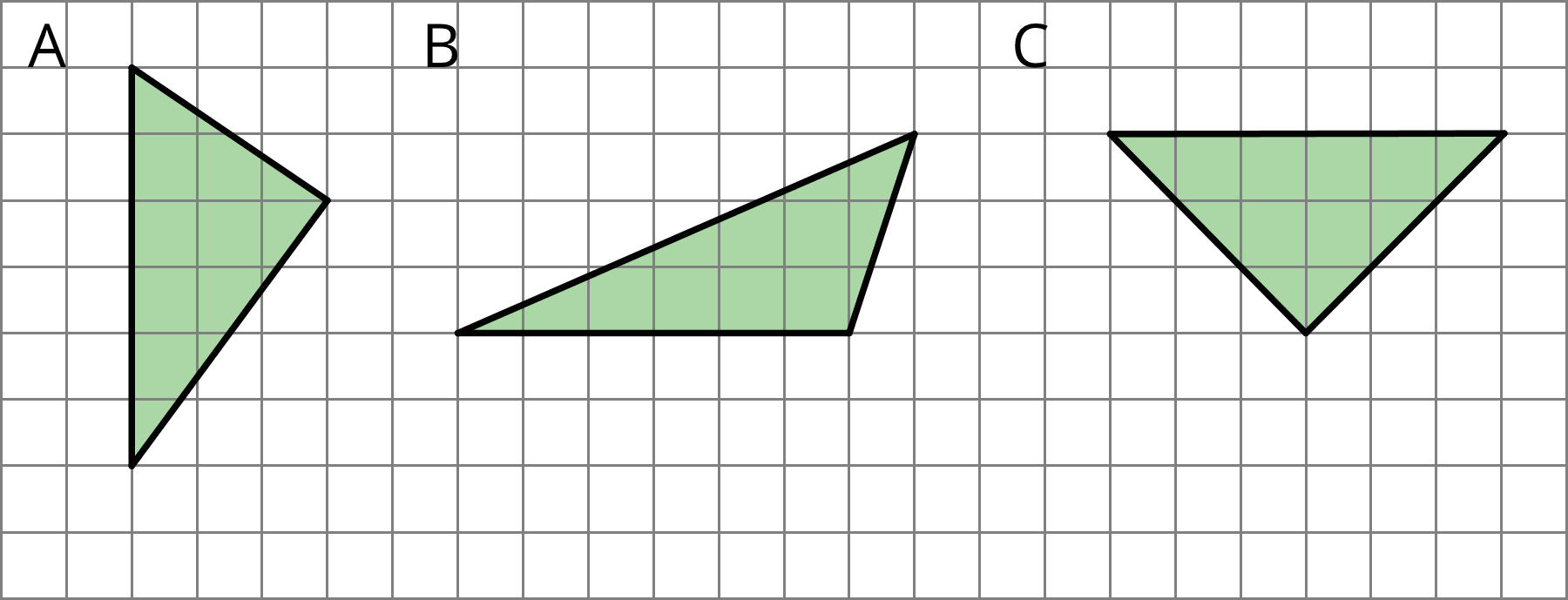
Problem 5 (from Unit 1, Lesson 9)
- A parallelogram has a base of 12 meters and a height of 1.5 meters. What is its area?
- A triangle has a base of 16 inches and a height of \frac18 inches. What is its area?
- A parallelogram has an area of 28 square feet and a height of 4 feet. What is its base?
- A triangle has an area of 32 square millimeters and a base of 8 millimeters. What is its height?
Problem 6 (from Unit 1, Lesson 3)
Find the area of the shaded region. Show or explain your reasoning.

Lesson 14
Problem 1
Can the following net be assembled into a cube? Explain how you know. Label parts of the net with letters or numbers if it helps your explanation.
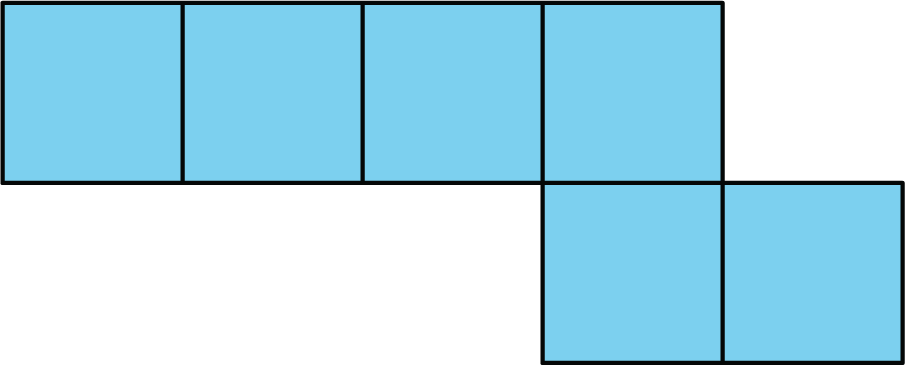
Problem 2
- What polyhedron can be assembled from this net? Explain how you know.

- Find the surface area of this polyhedron. Show your reasoning.
Problem 3
Here are two nets. Mai said that both nets can be assembled into the same triangular prism. Do you agree? Explain or show your reasoning.
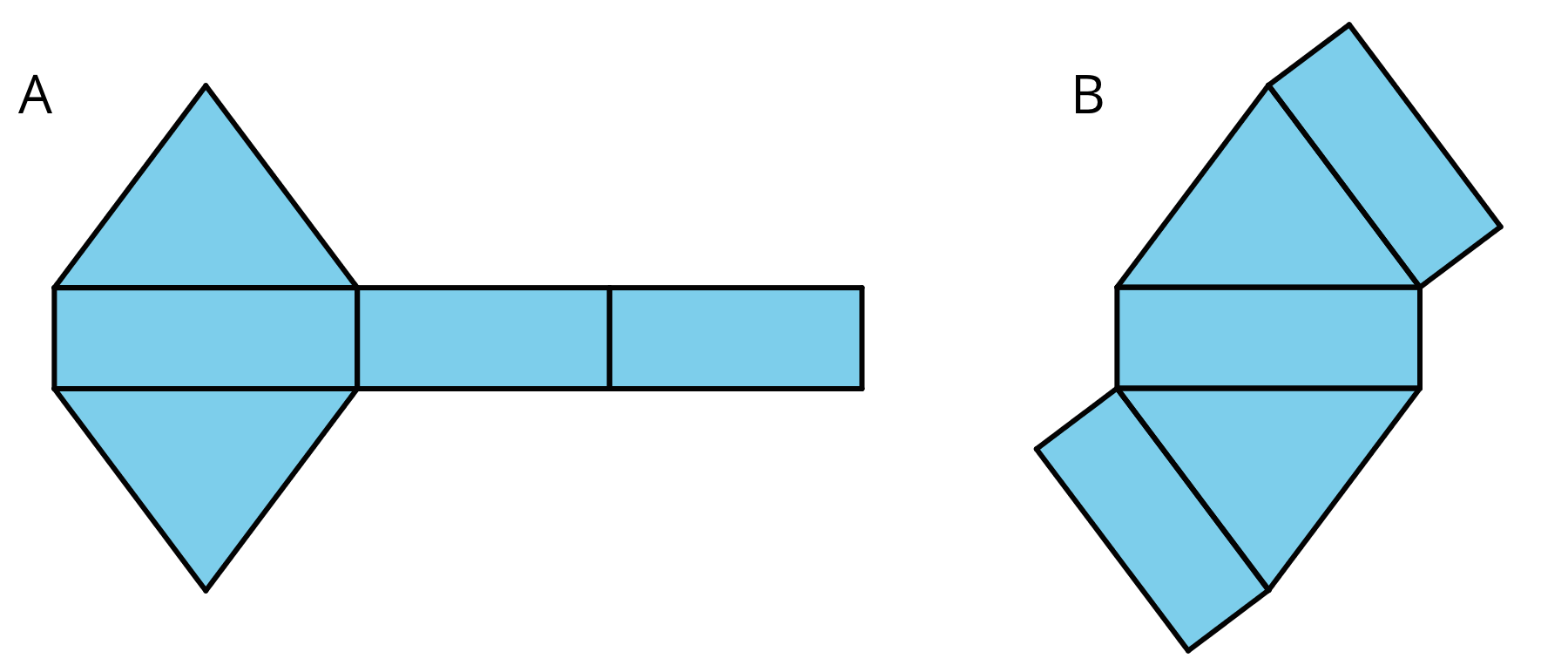
Problem 4 (from Unit 1, Lesson 13)
Here are two three-dimensional figures.

Tell whether each of the following statements describes Figure A, Figure B, both, or neither.
- This figure is a polyhedron.
- This figure has triangular faces.
- There are more vertices than edges in this figure.
- This figure has rectangular faces.
- This figure is a pyramid.
- There is exactly one face that can be the base for this figure.
- The base of this figure is a triangle.
- This figure has two identical and parallel faces that can be the base.
Problem 5 (from Unit 1, Lesson 12)
Select all units that can be used for surface area. Explain why the others cannot be used for surface area.
- square meters
- feet
- centimeters
- cubic inches
- square inches
- square feet
Problem 6 (from Unit 1, Lesson 11)
Find the area of this polygon. Show your reasoning.

Lesson 15
Problem 1
Jada drew a net for a polyhedron and calculated its surface area.
- What polyhedron can be assembled from this net?
- Jada made some mistakes in her area calculation. What were the mistakes?
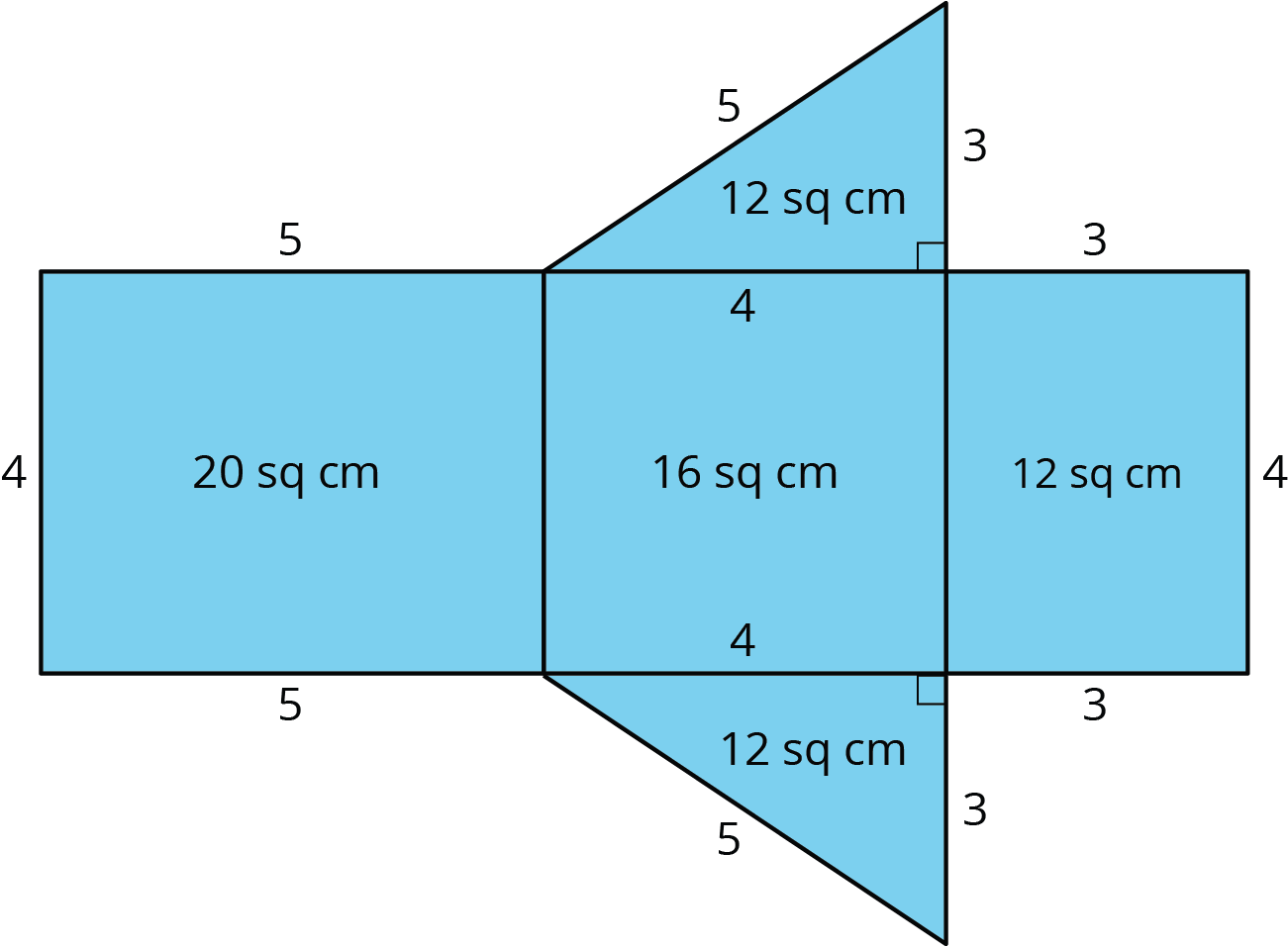
-
Find the surface area of the polyhedron. Show your reasoning.
Problem 2
A cereal box is 8 inches by 2 inches by 12 inches. What is its surface area? Show your reasoning. If you get stuck, consider drawing a sketch of the box or its net and labeling the edges with their measurements.
Problem 3 (from Unit 1, Lesson 12)
Twelve cubes are stacked to make this figure.
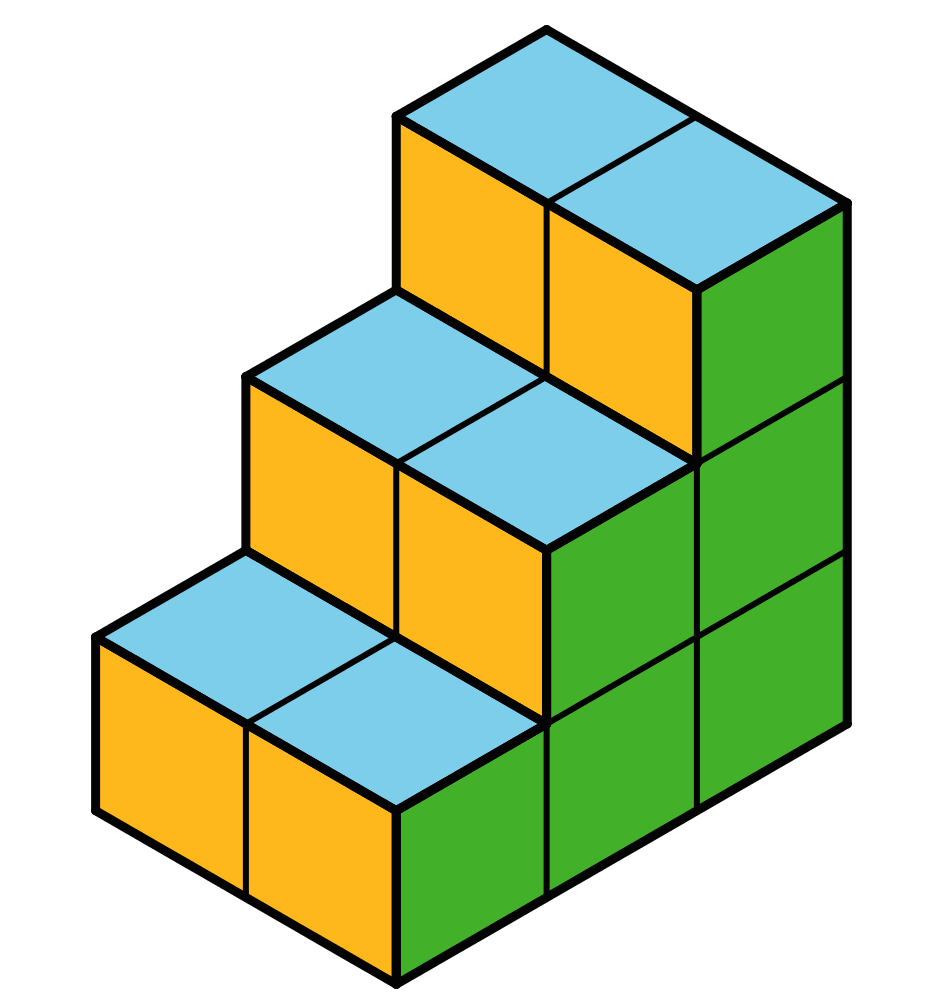
- What is its surface area?
- How would the surface area change if the top two cubes are removed?
Problem 4
Here are two polyhedra and their nets. Label all edges in the net with the correct lengths.
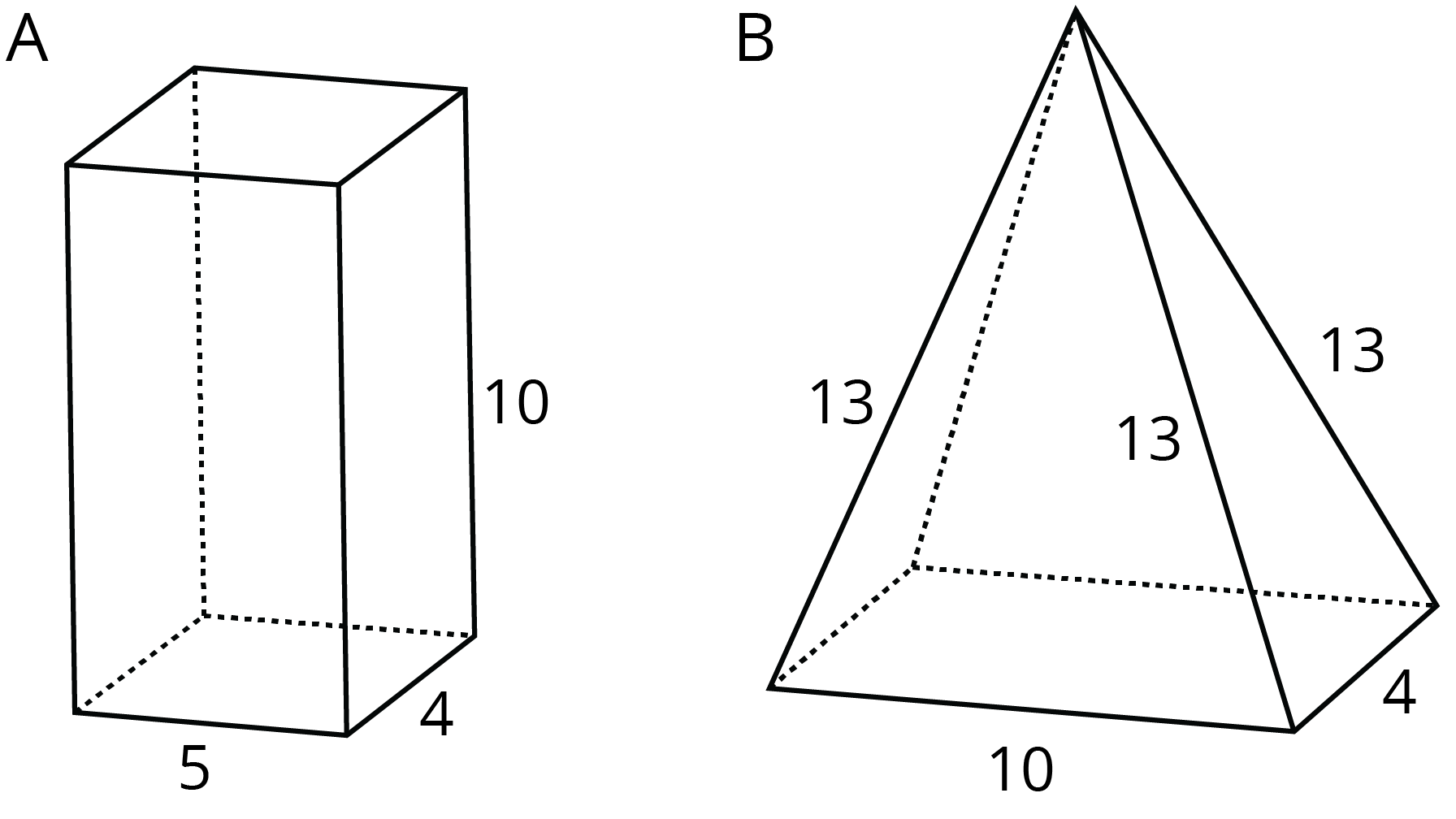
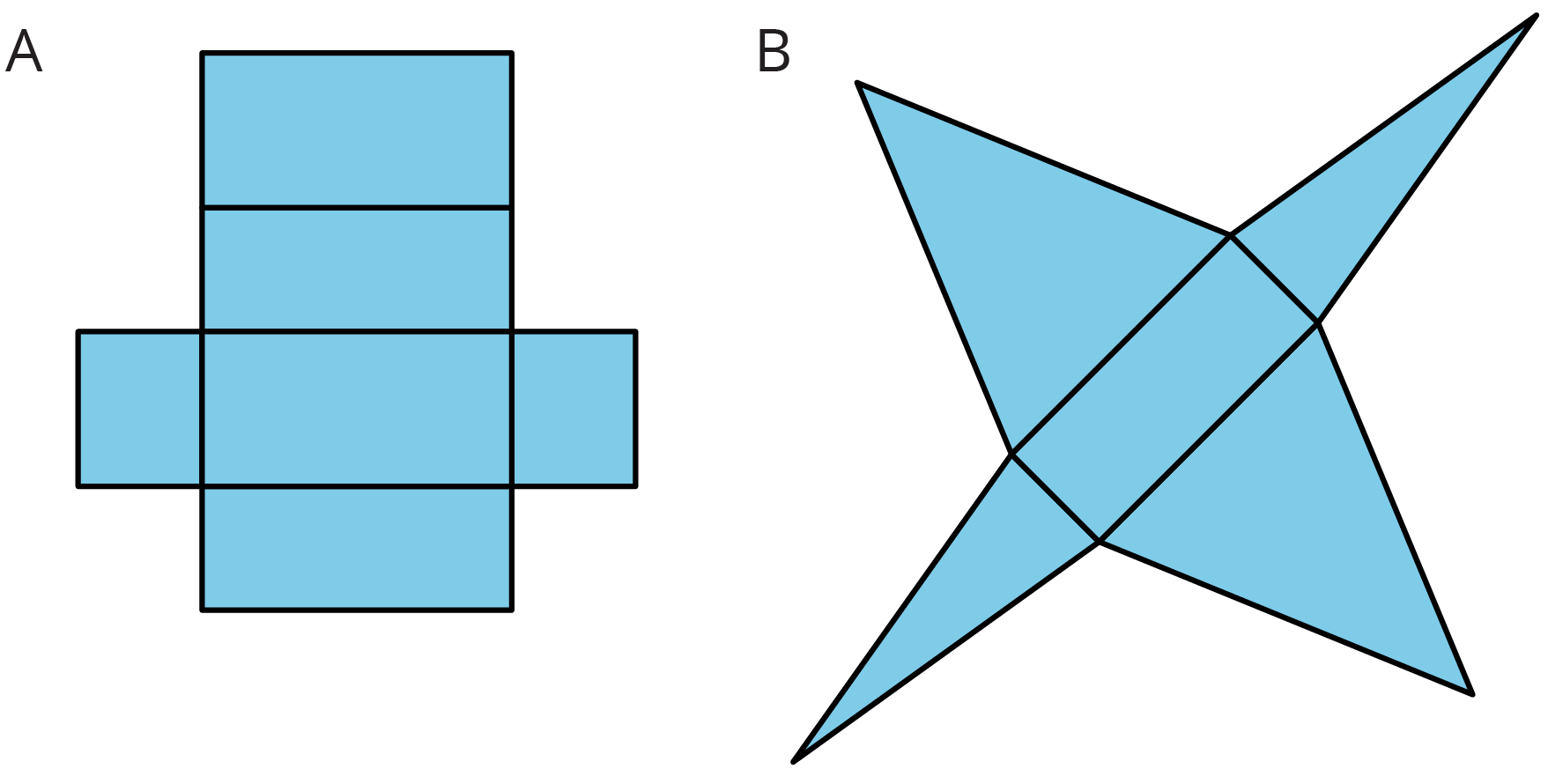
Problem 5 (from Unit 1, Lesson 14)
- What three-dimensional figure can be assembled from the net?
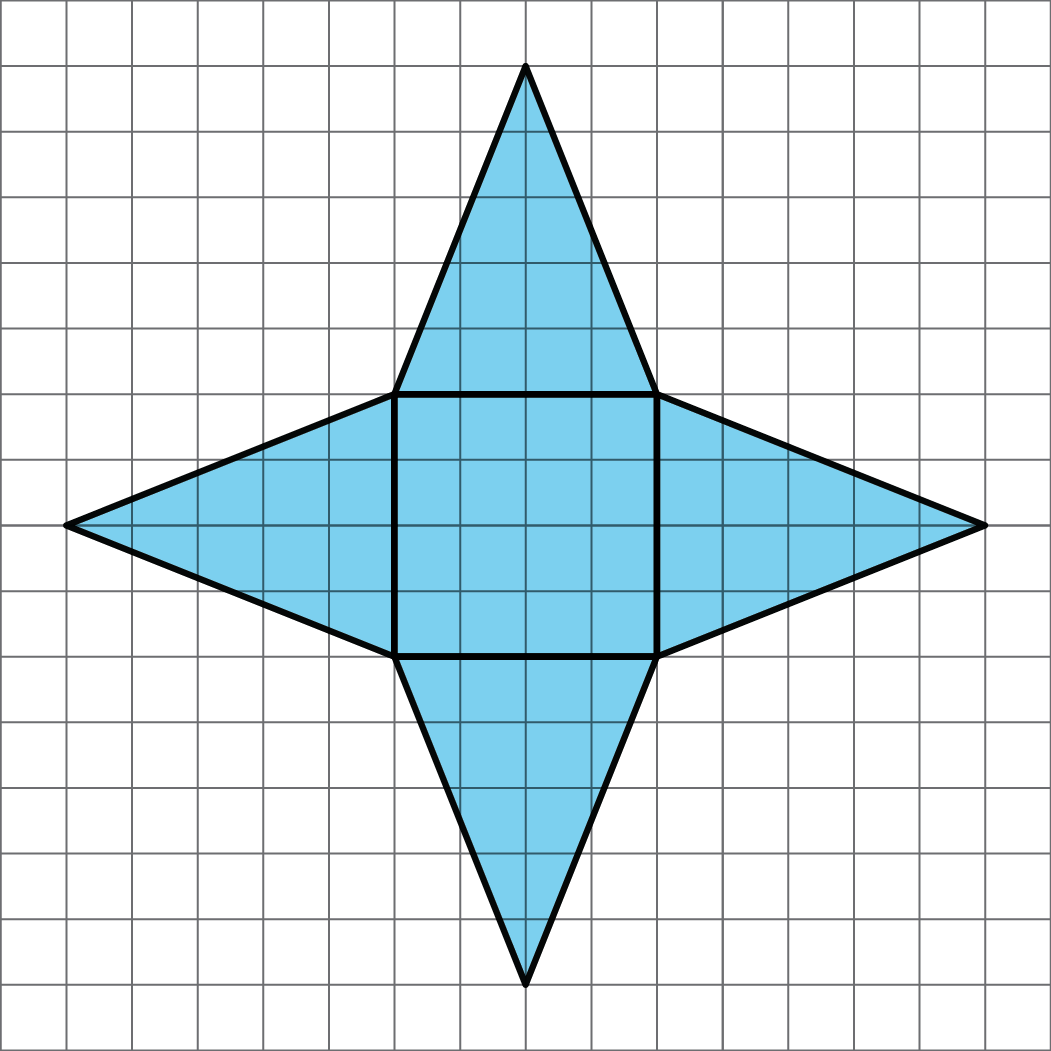
- What is the surface area of the figure? (One grid square is 1 square unit.)
Lesson 16
Problem 1
Match each quantity with an appropriate unit of measurement.
- The surface area of a tissue box
- The amount of soil in a planter box
- The area of a parking lot
- The length of a soccer field
- The volume of a fish tank
- Square meters
- Yards
- Cubic inches
- Cubic feet
- Square centimeters
Problem 2
Here is a figure built from snap cubes.
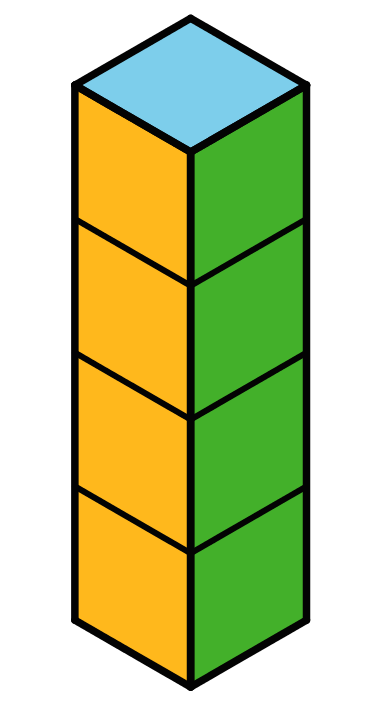
- Find the volume of the figure in cubic units.
- Find the surface area of the figure in square units.
- True or false: If we double the number of cubes being stacked, both the volume and surface area will double. Explain or show how you know.
Problem 3
Lin said, “Two figures with the same volume also have the same surface area.”
- Which two figures suggest that her statement is true?
- Which
two figures could show that her statement is not true?
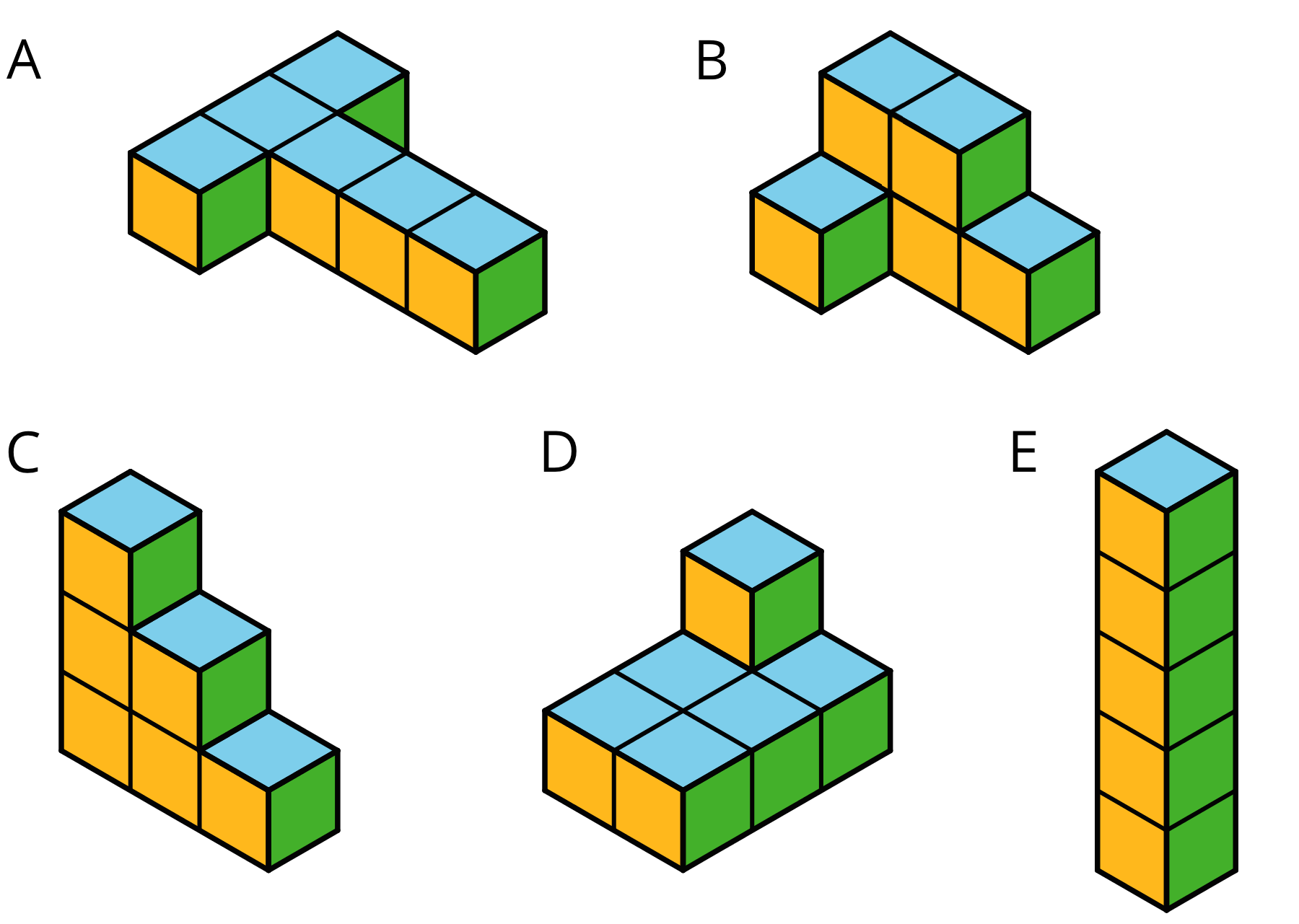
Problem 4 (from Unit 1, Lesson 11)
Draw a pentagon (five-sided polygon) that has an area of 32 square units. Label all relevant sides or segments with their measurements, and show that the area is 32 square units.
Problem 5 (from Unit 1, Lesson 15)
- Draw a net for this rectangular prism.
- Find the surface area of the rectangular prism.

Lesson 17
Problem 1
What is the volume of this cube?

Problem 2
a. Decide if each number on the list is a perfect square.
- 16
- 20
- 25
- 100
- 125
- 144
- 225
- 10,000
b. Write a sentence that explains your reasoning.
Problem 3
-
Decide if each number on the list is a perfect cube.
- 1
- 3
- 8
- 9
- 27
- 64
- 100
- 125
b. Explain what a perfect cube is.
Problem 4
-
A square has side length 4 cm. What is its area?
-
The area of a square is 49 m2. What is its side length?
-
A cube has edge length 3 in. What is its volume?
Problem 5 (from Unit 1, Lesson 16)
Prism A and Prism B are rectangular prisms. Prism A is 3 inches by 2 inches by 1 inch. Prism B is 1 inch by 1 inch by 6 inches.
Select all statements that are true about the two prisms.
- They have the same volume.
- They have the same number of faces.
- More inch cubes can be packed into Prism A than into Prism B.
- The two prisms have the same surface area.
- The surface area of Prism B is greater than that of Prism A.
Problem 6 (from Unit 1, Lesson 14)
- What polyhedron can be assembled from this net?
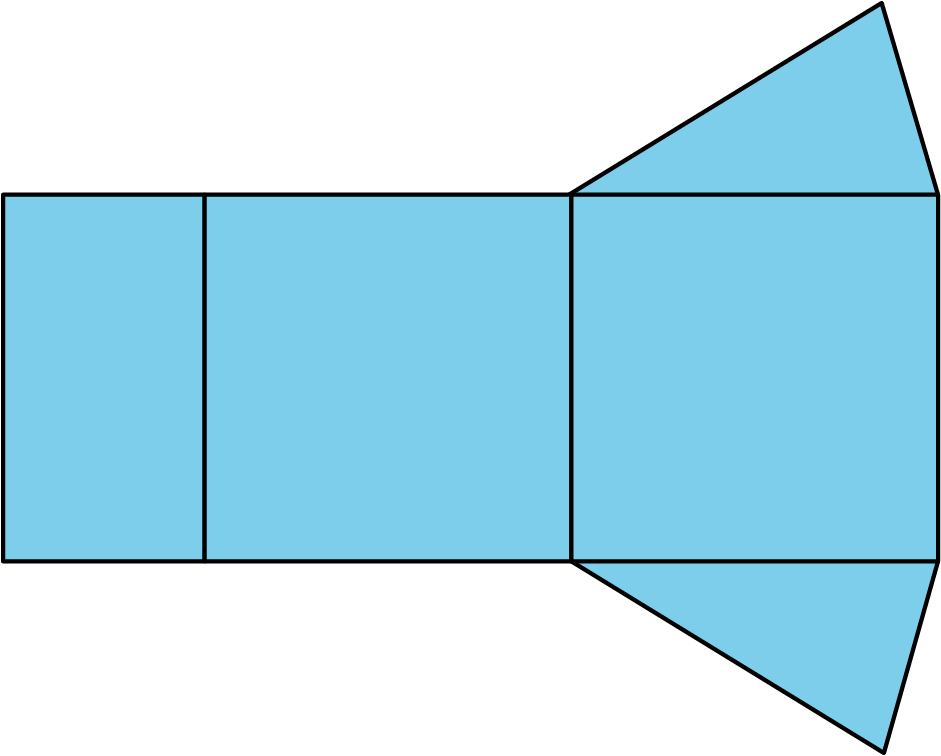
- What information would you need to find its surface area? Be specific, and label the diagram as needed.
Problem 7 (from Unit 1, Lesson 15)
Find the surface area of this triangular prism. All measurements are in meters.

Lesson 18
Problem 1
-
What is the volume of a cube with edge length 8 in?
-
What is the volume of a cube with edge length \frac 13 cm?
-
A cube has a volume of 8 ft3. What is its edge length?
Problem 2
a. What three-dimensional figure can be assembled from this net?
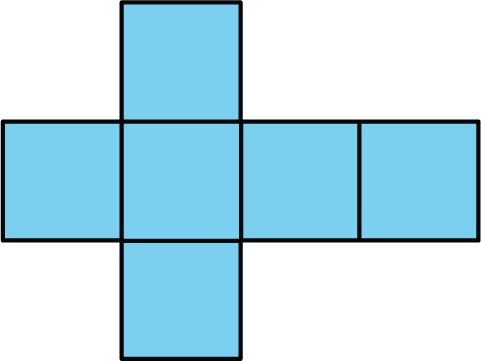
b. If each square has a side length of 61 cm, write an expression for the surface area and another for the volume of the figure.
Problem 3
-
Draw a net for a cube with edge length x cm.
-
What is the surface area of this cube?
-
What is the volume of this cube?
Problem 4 (from Unit 1, Lesson 14)
Here is a net for a rectangular prism that was not drawn accurately.
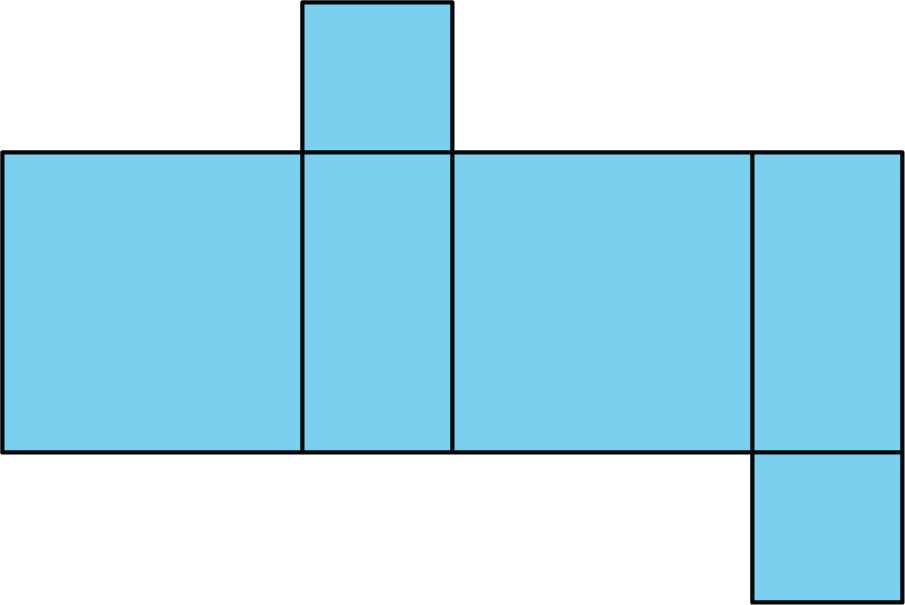
- Explain what is wrong with the net.
- Draw a net that can be assembled into a rectangular prism.
- Create another net for the same prism.
Problem 5 (from Unit 1, Lesson 13)
State whether each figure is a polyhedron. Explain how you know.

Problem 6 (from Unit 1, Lesson 12)
Here is Elena’s work for finding the surface area of a rectangular prism that is 1 foot by 1 foot by 2 feet.

She concluded that the surface area of the prism is 296 square feet. Do you agree with her conclusion? Explain your reasoning.
Lesson 19
No practice problems for this lesson.